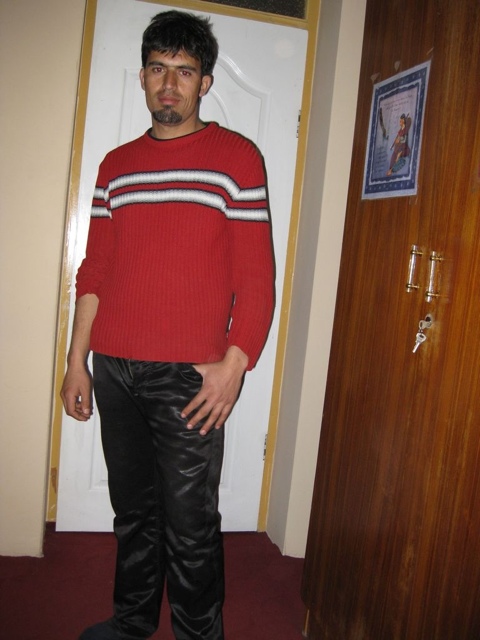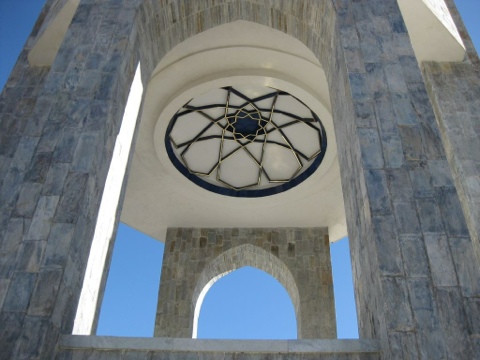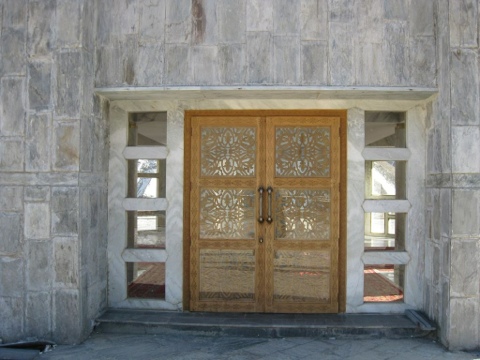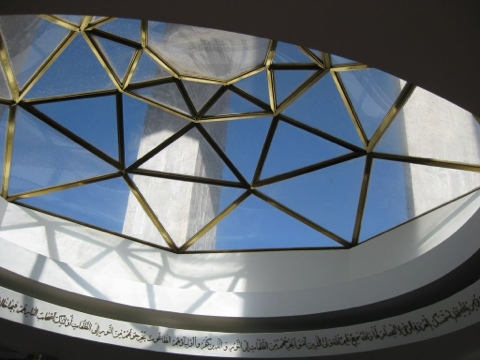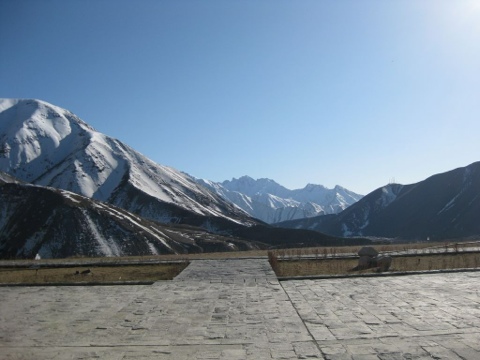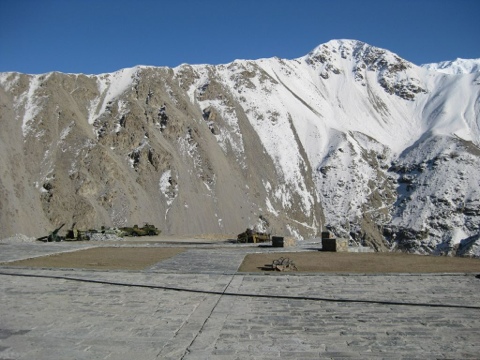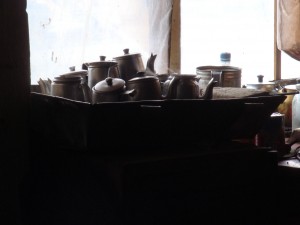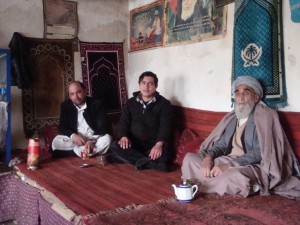Table of Contents
Before I start pontificating, I’d like to give my thanks, in roughly chronological order, to the people who supported me and made the trip possible:
My mother
Obviously it all starts with my mom, but it all ends with my mom too. I just read this story which made me realize how much I look forward to seeing my mother at the end of a trip. It’s almost worth going away.
Also, when you ask yourself what your parents thought about their child going to Afghanistan, my mom said she would come with me if she could get the time off work. I also got my father’s blessing before I left. I’ve been studying the country for almost 10 years now, it was really came as a surprise to no one.
The Putney School
I wanted to thank Ines Gomez-Ochoa for suggesting and leading the project week that peaked my interest in the country. Through her, I got the opportunity to spend time with a group of women on the supreme court in Afghanistan. In their exotic Dari Persian they told stories of their homeland and we sang songs and laughed into the evenings. They were proud of their families and traditions and held their hijabed heads high. I found these women truly inspirational and it was this experience that led me to Near Eastern Studies in college.
Not to sound totally cheesy, but I also wanted to thank the Putney community in general, everyone I talked to from Putney has been supportive and encouraging about my trip, especially the guys I saw in New York before I left; I talked to quite a few haterz who were unable to be happy for me that I wanted to thank the Putney people for being able to be excited for me (or mirror my own excitement back at me).
Patricia Whalen the International Association of Women Judges and the Afghan Women Judges Association.
I’m so glad I got to meet Patty, she was there at the beginning and has been great about keeping in touch over the years. Her work with the IAWJ is really interesting and innovative and I feel so lucky to know her. When I talk about women judges in Afghanistan, most people don’t believe that they exist, but they do and they have for quite some time. the AWJA is proof.
Prof. Saeed Gahremani
After the project at Putney I wanted to learn Persian when I went to college. Prof. Gahremani was my first and greatest Persian teacher who taught me to love Persian poetry and bore with me as I had a sustained anxiety attack during every single Persian class.
TAs Azad Sadr and Hani Khafipour
Helped talk me through my weekly anxiety attacks, and didn’t laugh at me as I learned the alphabet and made zero sense for two years.
Prof. Rakhmon Inomkhojayev
While Doctor Gahremani taught me about Persian culture, Professor Rakhmon taught me that Afghan culture was not just about the Persian legacy, but Pashtun and other traditions as well. That class opened my eyes to America’s involvement in the country with ROTC students. I’m sorry I don’t remember everyone’s name in that very small class, but thanks to you guys too.
Professor Bashir was really supportive of my interest while I was at the University of Chicago, she taught a Balochi class that I took and as a member of the American Institute of Afghan Studies she was helped connect me to some great contemporary sources for my thesis.
Arlene Blum
A family friend, who wrote the recommendation that got me the scholarship to go on the trip. She has also been to Afghanistan before and by example showed that it was possible. She has introduced me to various people who are still involved there.
Anna Elliot
Another friend who has been to Afghanistan; when she started her Bamyan project it made me sure that it was possible for me to travel to the area. If Anna could do it, so could I.
Global Exchange
I had been looking for someone who would take me to Afghanistan since I started studying it in college (there’s no school year abroad in Kabul, much to my chagrin). Global Exchange was right under my nose the whole time, and I got a chance to go on the 10 year anniversary International Women’s Day trip, how lucky is that? Thanks to the organizers, Andrea Hightower in San Francisco, and Najibullah Sedeqe, our tireless traslator and tour-guide in Kabul. Thanks also to my fellow travelers, Tim Kutzmark and Salena Tramel.
Why did you go to Afghanistan?
I’ve been trying to go to Afghanistan for almost 8 years. I became interested in Afghanistan in high school when I met Patricia Whalen the International Association of Women Judges and the Afghan Women Judges Association. In college I was a Near Eastern Studies major, I studied Persian and Pashto and wrote my thesis on the Legal Systems of Afghanistan. While the University of Chicago supported my studies, I couldn’t find anyone to support a trip to do research.
Who did you go with?
I went with Global Exchange on their International Women’s Day in Kabul Reality Tour. It is their 10th year of doing reality tours in Afghanistan. The trip focused on women’s rights and women’s organizations as well as other NGOs and peacekeeping organizations.
Our tour-guide and translator was Najibulla Sedeqe, who was instrumental in parlaying (sp?) our way into some really interesting situations. My fellow travelers were a Unitarian Minister named Tim Kutzmark and freelance journalist named Salena Tramel.
How did you get there?
My flight went from New York to Frankfurt, Frankfurt to Dubai, Dubai to Kabul.
Where did you stay?
We stayed at the Afghans for Tomorrow Guesthouse which I think is mostly aptly described as kind of a bed and breakfast. Downstairs were the offices for Afghans for Tomorrow. We had a cook, a maid, a porter/night guard and pretty much anything you could ask for.
How is your Arabic?
Terrible, I don’t speak Arabic, but neither do Afghans. In Afghanistan they speak a Persian dialect called Dari and another indo-european language called Pashto. In college I learned the Iranian dialect called Farsi which is very similar to Dari and I took an intensive Pashto course one summer. I didn’t really want to risk being misunderstood in the complex political discussions we were having during the day, but in the mornings and the evenings I was able to talk to the guest house staff in Farsi.
How did you deal with the heat?
Afghanistan is considered the Middle East, but it’s not a part of Arabia or North Africa; it’s not a desert. It’s a mountainous region of Central Asia and as such, the weather was really quite cold. The snow was just starting to melt during the first week of March, and it was 30°-50° F during the day and colder than that at night.
What was a typical day?
We did about equal parts sight seeing and meeting people. Our first meeting was usually around 9, so the 5 of us (Zarif, the driver, Najib, the tour guide, Tim, Salena and myself) would all pile into the toyota corolla around 8:30 and to go to a meeting or two in the morning. Then we would stop for lunch at a restaurant. After that we’d have another meeting or go to see a sight in the afternoon and return home by dark, around 5 or 6. I’d write in my journal, we’d eat dinner at the house and I’d fall asleep.
What did you eat?
Bread and tea were the staples of my diet in Afghanistan. The bread is like the naan you would find at an indian restaurant (except fresher and better) and the chai was generally weak green tea, which was perfect for me because it was just enough caffeine to get through the meeting, but not enough to make me crazy. The tea also kept us warm when not all the buildings were well heated. Every single place we went they offered us tea.
For breakfast we had tea and bread with cheese or jam, and the cook often made us scrambled eggs.
For lunch we ate out at nice-ish restaurants and ate kebabs, rice, bread, sometimes soup, dumplings or curry.
For dinner we had soup and a vegetable dish of some sort, our favorite was eggplant, but we also had delicious cauliflower curry and dumplings.
What did you wear?
I wore the hijab, and I’m glad I did since I didn’t see one woman in public without it. Every islamic country has a different interpretation of women’s dress, in Afghanistan the norm was long loose pants, a long sleeved tunic or shirt that went past your hips and a hijab. It was really cold so I also had a long coat on every day. I wrote a little more about it on this earlier post.
What was the situation for women there?
I’ve been asked this question a few times and I don’t really know how to answer it. I’ll just say this, there were women in almost every job in Afghanistan, police officers, judges, judo masters, doctors, etc. but the only single women we met were widows, and we didn’t meet any women who didn’t have children. We rarely saw women on the street on the weekends (Thursday and Friday are the weekend in Kabul) and in more conservative areas we saw women only in burkas.
Where did you go?
We stayed mostly in Kabul but we took a day trip to the Panjshir valley to see Massoud’s tomb and a day trip to the village of Istalif.
Did you take pictures?
I did, but unfortunately my house was robbed last week and they stole the camera with most of my pictures on it before I got a chance to upload them. My fellow travelers took some great pictures though so I will link to them, and I also have one memory card with some of my pictures but I haven’t been able to see what was on it.
How did they feel about Americans and the War on Terror?
In Kabul I heard 3 things with surprising consistency; the biggest problem or challenge in the country is lack of security, the Pakistani government is to blame for many of the country’s problems (that the US should stop funding Pakistan) and everyone we asked wanted to keep US or international involvement in some respect. We talked mostly to middle-class urbanites in Kabul, but this was the anecdotal evidence we were able to gather.
You can see the evidence of 30 years of war in and around Kabul, in every neighborhood our tour guide pointed out a building that had a suicide bomb attack, the palace and museum were destroyed, we went through check-points almost every day. But I can’t imagine what it’s like in the countryside.
What about the Qur’an burning and the massacre
I got to Afghanstan days after the Qur’an burning and the streets were calm. Our tour guide told us that there had been some peaceful protests where the police took care of security, but that these were over. The people we talked to were very upset about what happened, but they had heard Obama’s apology and they understood that it was an accident, they also said their mullas had told them to be patient and calm. I was in New York when the massacre happened and haven’t heard what the Afghan reaction has been.
Apologies for not updating last week. Between packing, traveling, and finishing up all those letters I’ve been pretty busy. The power is not consistent here in Kabul but I will try to update when I can. I’ve been taking pictures but I probably won’t be able to upload them until I get back, I’m writing from my iPod touch so forgive the spelling and formatting.
Framing the Conversation – March, 2, 2012
I arrived in Kabul this morning. Two days ago I was in New York staying with a friend from high school. He is a highly skilled craftsman who makes, among other things, gorgeous wooden frames. He recently found a rare New York apartment that let him set up a small woodworking studio downstairs and he’s saving up for a bandsaw.
Today I visited another place that makes frames; Golestan Sabak. This school, run by a wonderful widow named Fatima Akbari, teaches women and children. The students learn not just literacy but also vocations like embroidery and carpentry. In particular we visited the workshop where disabled people learn woodcarving, calligraphy and frame-making. 3 weeks ago a big snow dump caused her tent to collapse, destroying their electric saw.
Another recent New York conversation echoes in my head. My friend and I were eating lunch at Columbia where some students were protesting the settlements in Gaza. I asked my friend how he felt about the protest and he said essentially ‘Think Globally Act Locally’ that there are plenty of problems to deal with in New York. But one of the problems is misinformation. People who don’t know about the settlements or about women’s carpentry workshops in Afghanistan. Well maybe a couple people do now.
Naqib the Guard – March 5, 2012
Naqibulla is the night guard at the guest house where I am staying. We hit it off initially because he was impressed that I speak some Farsi (my Persian is okay, I can have simple conversations which is fine for the night porter but not great for interviewing a member of parliament, I leave that to our tour guide and translator extraordinaire, Najib). He likes my Iranian accent because during the Taliban he moved to Iran with his family.
He is also stunned by my ‘seeah post‘ or black skin. He says he likes black people. They are good people. There are none in his country bit there is a region in Iran called Bandar Abbas that has a lot of Africans. He played me a bandari music video on his phone and showed me his black friend on Facebook (who looked South Asian to me).
He says we are like brother and sister now. He gives me extra blankets and extra wood for my woodstove at night. When I woke up in the morning and my voice was hoarse he asked if I was sick and if my room was warm enough. It was just that he was the first person I’d spoken to, but it was sweet that he was concerned.
He is about my age, 22, but he says since I am a year older that in Afghan culture he should wait on me and bring me chai. He is married and only had 4 years of school because of the problems in his country. In the states when you are a student it means you are poor, here it means you are rich enough to that your family can afford to not have you working. I have gone from the 99% to the 1%, and it feels very strange to have a cook, a driver, a maid and a porter for a week.
Today he asked if i could take a picture with him before I leave. I’m sure he’ll want to show everyone his black friend.
It’s all pretty politically incorrect and frankly makes me a bit uncomfortable, but this whole trip is about stepping outside of my comfort zone a bit, and Naqib is genuine and sweet.
Gotta brush my hair and put on a hijab before the cook comes in to tell me breakfast is served. Laterz.
Over the mysteries of female life there is drawn a veil, best left undisturbed
-Louisa May Alcott, Little Women
For the program they told us to make sure we put our headscarf on before we landed in Kabul. I decided to put mine on when I landed in Dubai. As I walked out of the bathroom I felt the way I do whenever I change my appearance; like everyone is staring. But after following the gaze of some onlookers I realized they weren’t staring at me, they were staring at the girl in the polka dot miniskirt.
I became accustomed to it quickly (though practically I still find it difficult to walk in the wind without losing my scarf and to eat without eating my scarf or spilling on it); it seemed the least we could do to show respect for the culture of Afghanistan. We saw no woman outside without a hijab (and inside only twice, with a hijab around her neck). The first days we were there, Thursday and Friday, are the weekend in Kabul and we saw almost no women on the street, only rarely a woman in burqa (chador), who was presumed to be a widow, because, presumably, there is no reason for a woman to leave her house on this day save desperation.
I noticed 3 types of women’s dress, the chador, a more conservative working woman outfit, and a more fashion-forward style. In older parts of town and on holidays we saw many blue burqas but during the week we mostly saw type two, working women with long loose pants or a long skirt, a long-sleeved top which covers the rear and a scarf wrapped loosely around the head. Walking around town, most of the women we saw were going to and from work (the university was over winter break still) and chose this style in earthy colors. The last category I saw in upper class neighborhoods, and occasionally in fancy restaurants, it was very westernized with skinny jeans, pointy black boots to kill, a long sleeved top and a tight hijab often in loud colors with sparkles and jewels. I felt my clothes fit squarely into the middle category, however with my height, I think from behind I probably looked most like an Afghan man. It was very cold and it is not uncommon for a man to tie a scarf around his head during the winter. The men’s traditional dress is actually quite similar to the women’s.
We were quite the spectacle nonetheless, in a country where one’s ethnicity is easily identifiable by their face and dress, we were a blonde woman taking pictures, a fair man in khakis and a tall black woman. We were tourists, but in a country with such little tourism, no one could place us. So they stared. and stared. and stared. Children would stare, old men would stare, the few women we saw would stare. I didn’t know what it was that made them stare, had they never seen a black person? Someone so tall? A blonde? Was my hair showing? In these situations I was glad I had my headscarf, I would avert my gaze and pull the scarf across my mouth. This is a traditional response to unwanted attention and seemed to bring people’s attention to the fact that they were staring. Sometimes they didn’t stop, but at least they knew they’re were making me uncomfortable. In a world were manners and respect are so important, this tactic seemed to work wonders. In addition to hiding in plain sight, pulling the scarf over my mouth helped keep me from breathing in the thick Kabul dust and the smell of diesel on the road or heating gas inside.
Inside the guest house I would often wear a hoodie, it was difficult for me to brush and plait my hair every morning because it was so cold that overnight it wasn’t guaranteed to dry. Normally my hair is pretty large and in charge so this was a daily challenge. But I found I was rewarded with a new fashion accessory. It may sound inappropriate but I feel that after this experience I can safely integrate the hijab into my wardrobe in situations where I might be more comfortable with it. When I landed in Dubai, I stood on an escalator next to a woman who was literally wearing what I had on for underwear, skinny jeans and a nude camisole (over which I had a long skirt and a large sweater). I had decided I would take off my hijab when i felt comfortable doing do, sitting next to a muslim couple on the plane to DC it didn’t feel right or respectful to take it off. Walking through security the woman asked I could take my scarf off, I said I’d rather not. Finally in New York, walking around with two heavy bags I got hot and changed my clothes to haggle with a Jamaican woman about getting on an earlier flight. My hair looked horrible.
When I leave my room I still like having my hood up, and it’s been raining so I’ve had a good excuse for my scarfy/hoodie look. As a westerner I always wanted to wear the hijab but felt it would be offensive, maybe it still is, but now it feels comfortable and appropriate to me. It’ll fade but I’m happy to have it in the mix.
After hearing that my camera had been stolen, my fellow traveler Tim Kutzmark kindly sent me some of his pictures. He’s awesome. I’ll try to post a few of his pictures from each day.
This is a picture of the blue Ali mosque that we went to on the first day.

After a long day of traveling we walked through a nearby cemetery and took pictures of the houses on the hill.
Later we went to see Fatima Akbary, and her company, Golestan-e-Sabak, (I talked a little bit about her in a previous post). She was a widow who had founded an NGO to help women and underprivileged in her community, she ran a girls school, vocational training courses as well as women’s business training.
Below you can see her showing us what had happened over the winter. The tent she had built as a temporary workshop had caved in under the snow and her tools were ruined; she would be unable to fulfill a furniture order that spring.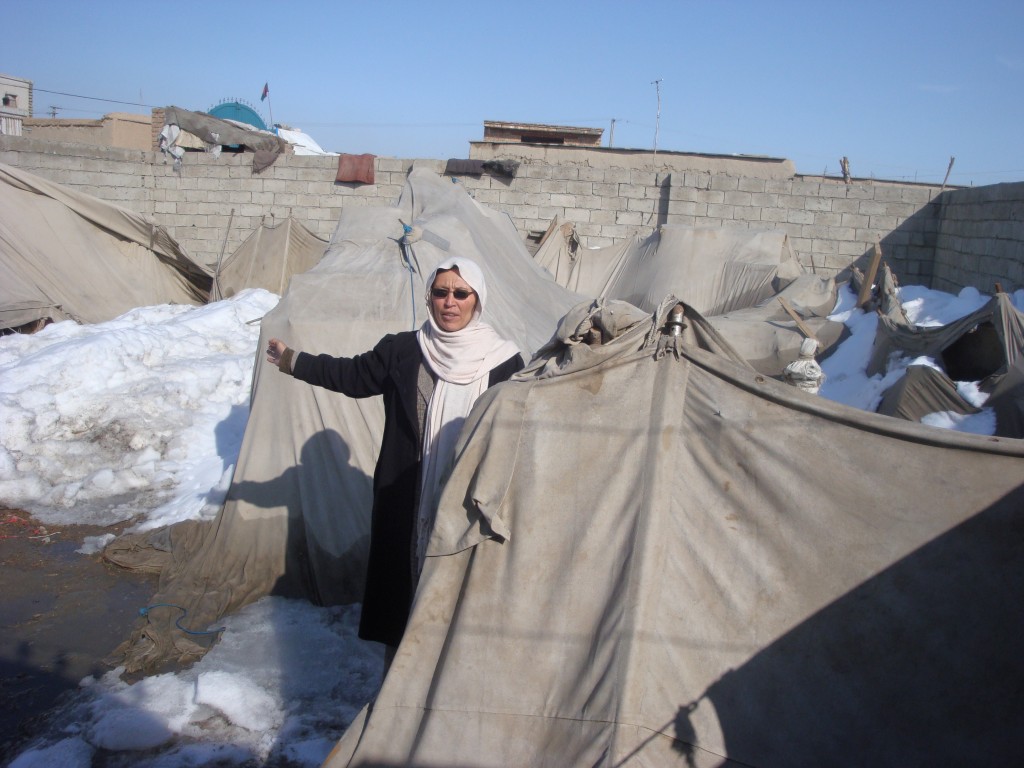
These are some girls in her class, the one in the pink hijab was reading aloud to us.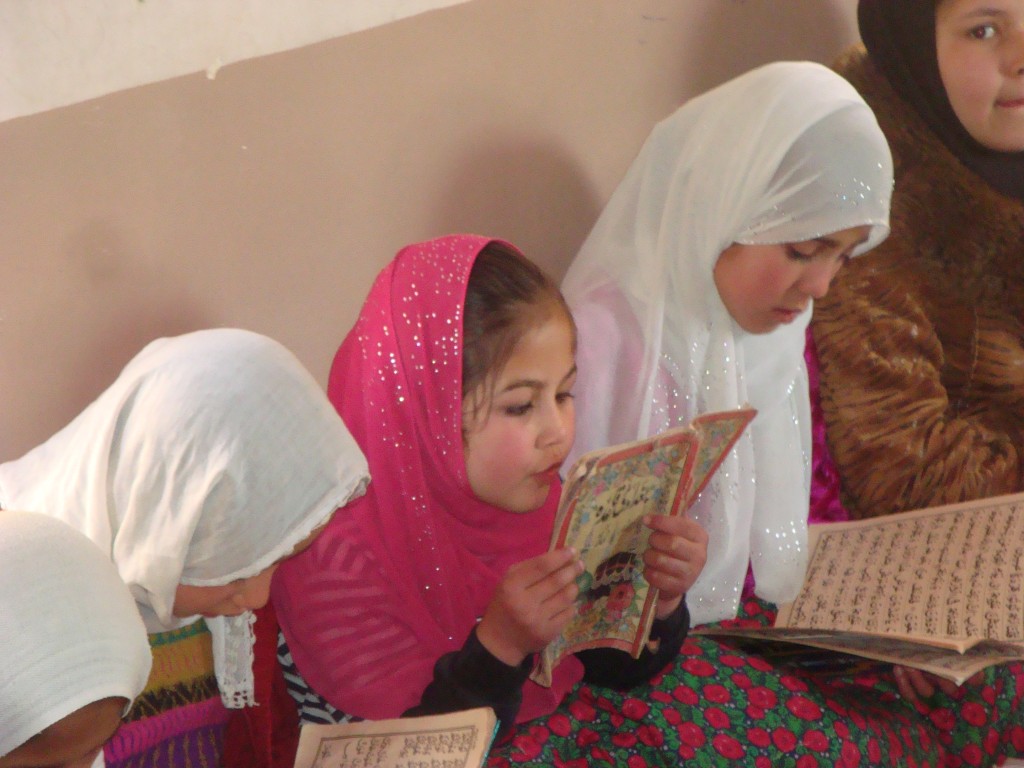
Fatima also teaches calligraphy and woodcutting to disabled people, a type of vocational training. This is some of the calligraphy they had done.
Thanks again to Tim for the pictures!
Day 2 was Friday, March 2. Friday in the Muslim world is like our Sunday, the day of rest.
First we went to this lake high in the mountains called Kargha Lake. In the spring it a destination with paddleboats and picnics. The lake was frozen when we visited, but the view was beautiful. You can see the waterline on this lookout house from when the snow has melted.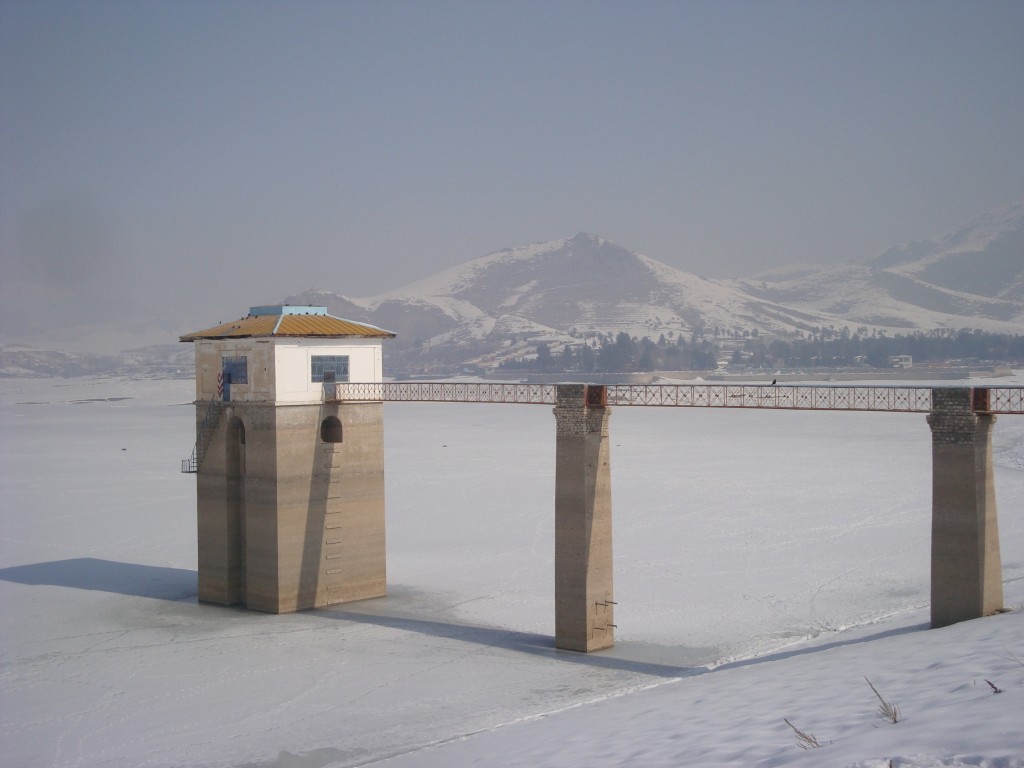
Next we went to a refugee camp called Charahi Qambar. This was a pretty singular experience worthy of its own post. For now, here’s a photo from outside the tent.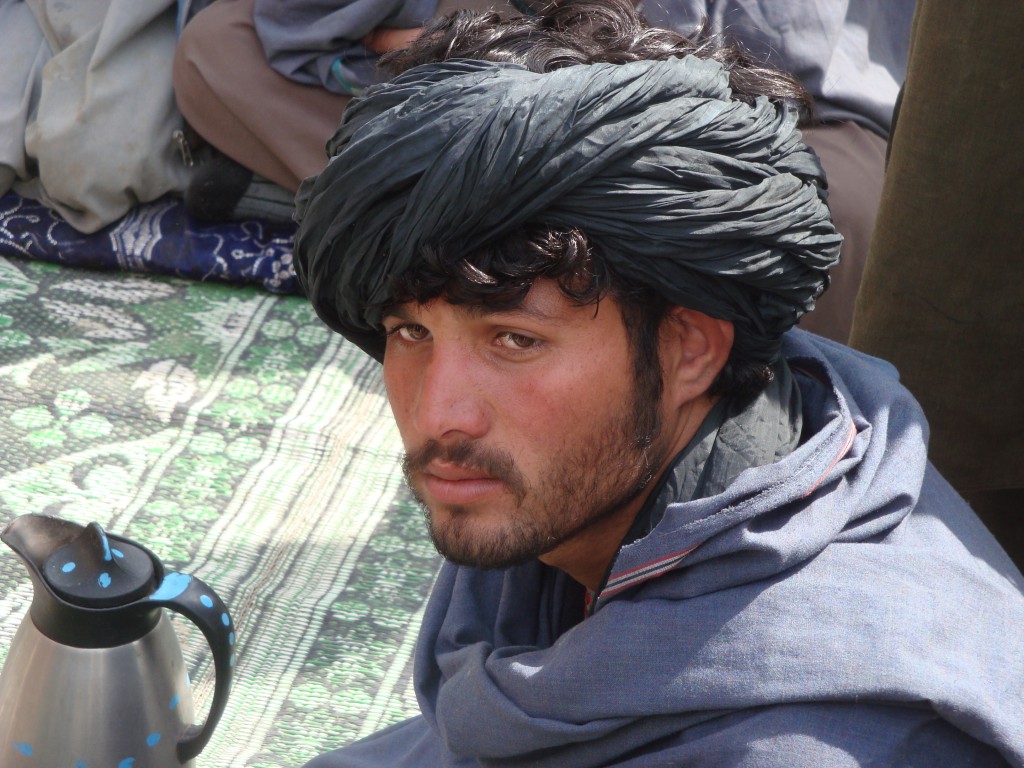
After you pray it’s time to play. These children were flying kites on the hillside after attending services. There were also people on the hill playing the Afghan national sport of bozkashi. When we first got there, there were a few kites in the sky, by the time we left the entire sky was full of kites.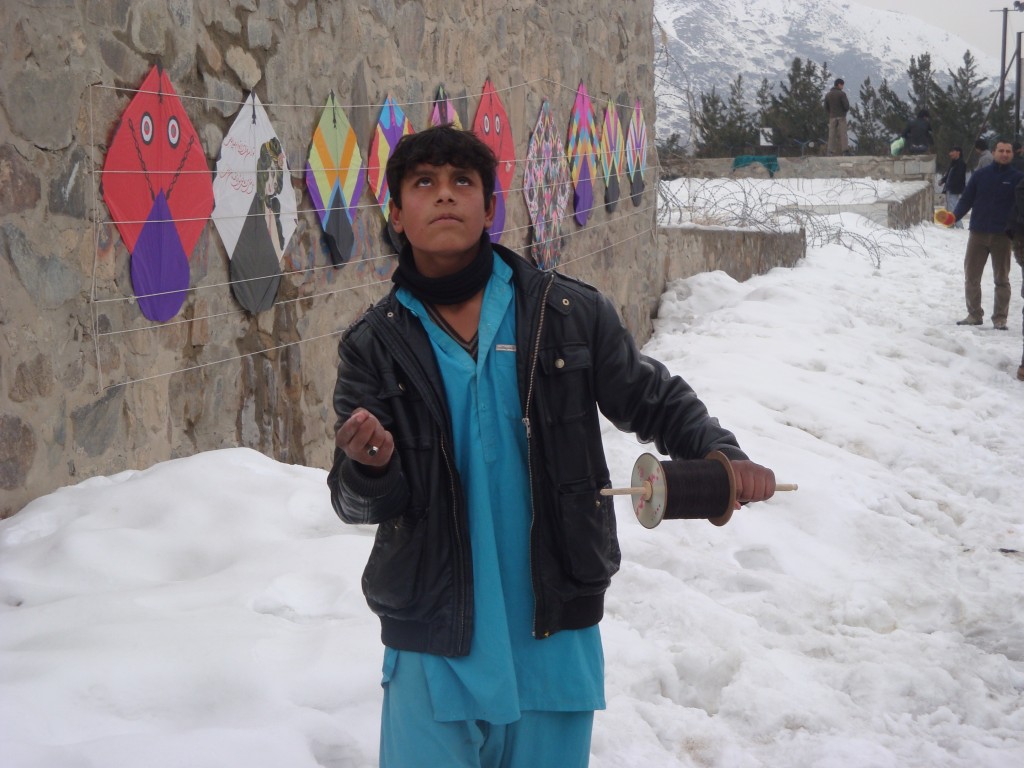
These two photos are from Babur Garden, a tomb and park named after the Moghul emperor Babur from the 16th century. During the spring this is also a popular picnicking destination.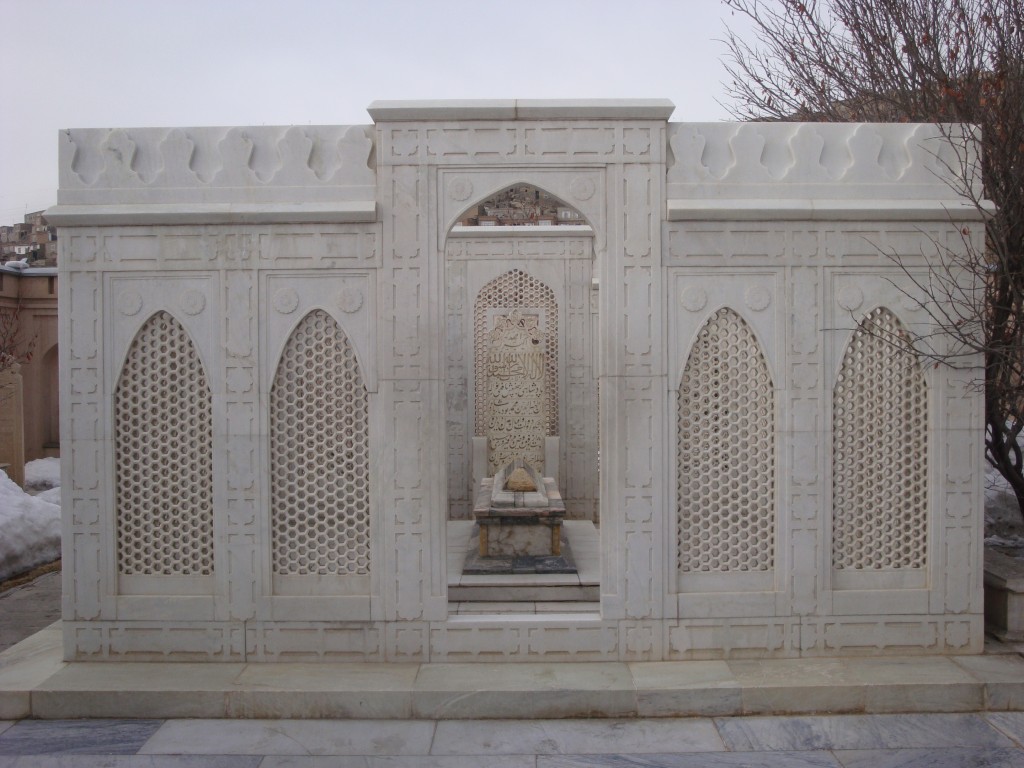
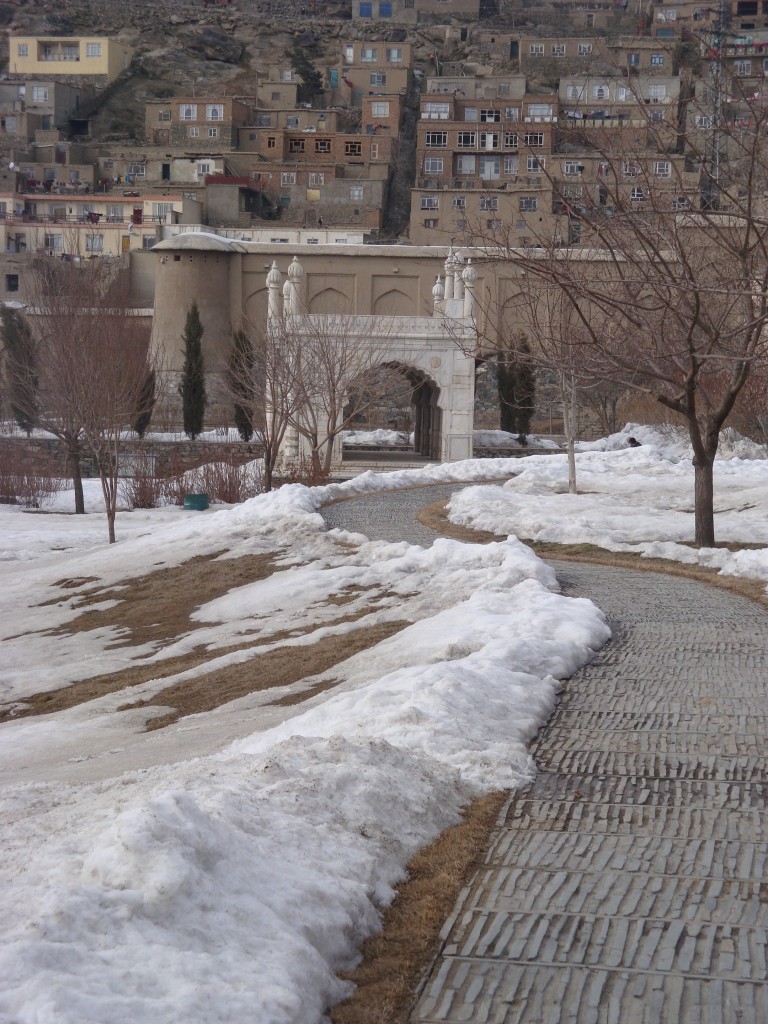
I kept the ticket to Babur Gardens because I liked the calligraphy: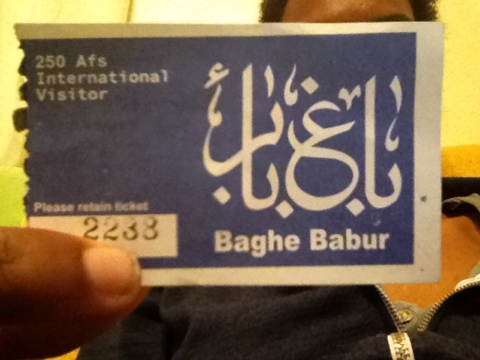
Returning home after a long day we were greeted by lambs and goats, or as we started calling them; kebabs.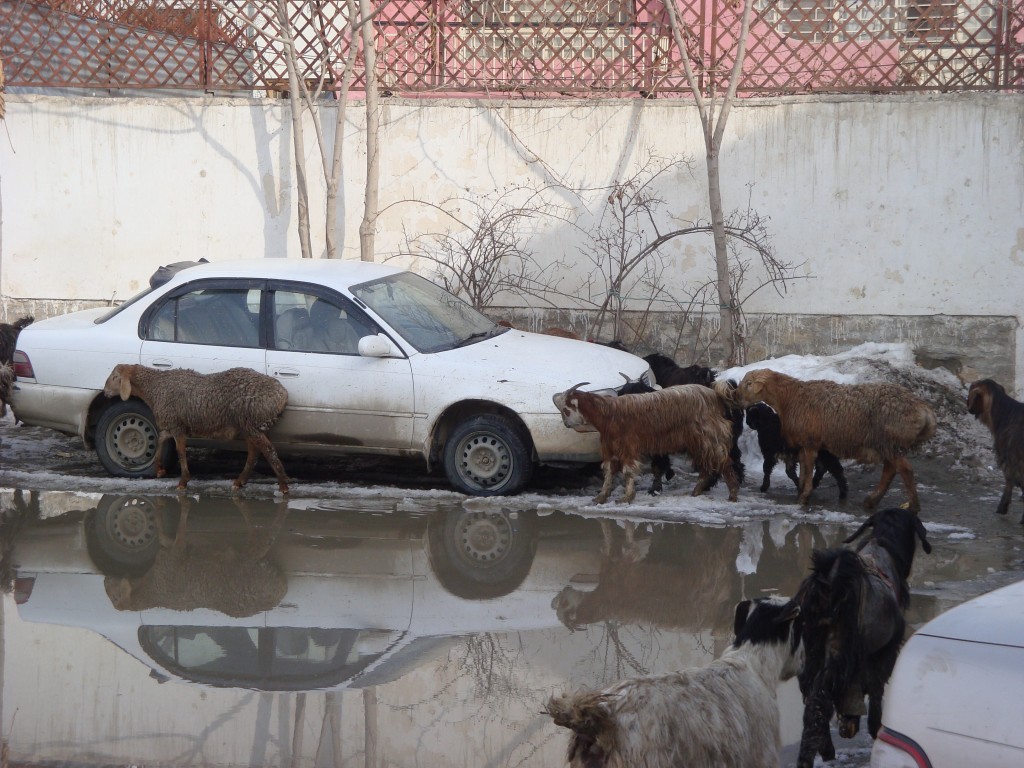
Saturday is the first day of the Islamic week, like our Monday. We got down to business for some serious meetings and visits. I remember it being particularly cold this day.
We started out by visiting the National Museum. We had to go through security first. We went through a lot of security checkpoints in Afghanistan; the guys generally got a patdown from the main guard with a gun and they asked the women to step into a back room, often behind a curtain, where a woman was waiting to check you. This time when we peeked behind the curtain there was a very old woman who wouldn’t let us leave without having some tea. While the men shivered outside, we drank green tea and smiled with this lady.
There were women working the ticket counter in the museum, though we saw few women on Thursday and Friday, we saw many women on Saturday as they returned to work.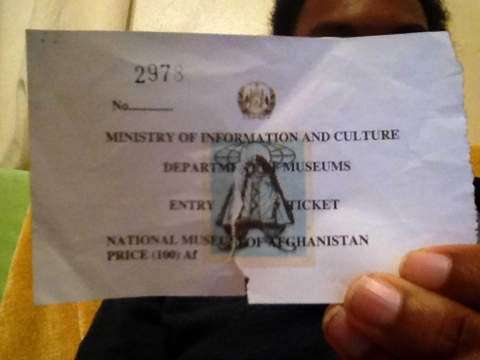
When we got inside the museum it wasn’t much warmer than outside, in fact, it was quite a bit colder. In the spacious and lofty museum, with its high ceilings, we found guards huddled around a single heater coil.
After walking around the first floor we were able to meet with the museum director, Omara Khan Masoudi. He told us that in 1992 the museum had 100,000 pieces, but after the Soviet Invasion and Taliban civil War 70% of them had been looted.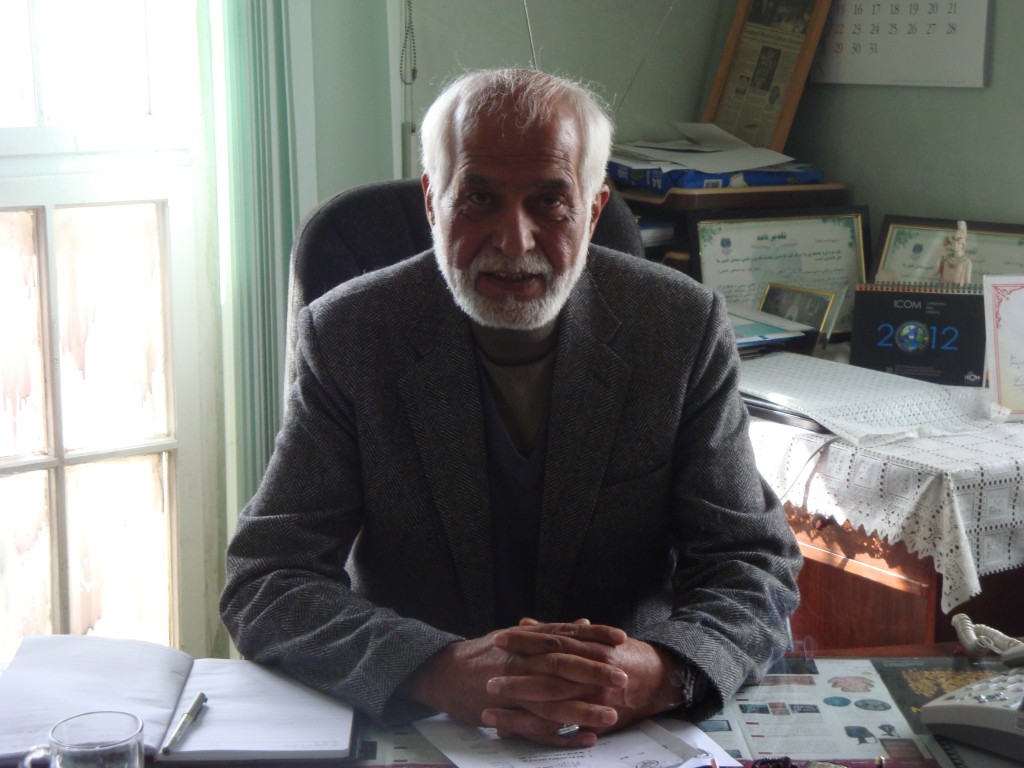
The image below was taken in 2001, the museum had no roof for two years during the war and thousands of pieces were destroyed. With a grant from National Geographic they have been able to inventory 52,000 pieces so far. Mr. Masoudi was hopeful for the future and was working on building a new building and 12 provincial museums throughout the country.
On display right outside the museum was the first steam engine in Afghanistan, alongside the official car of each King, Queen, or President of Afghanistan who had a car. There are a few pictured below: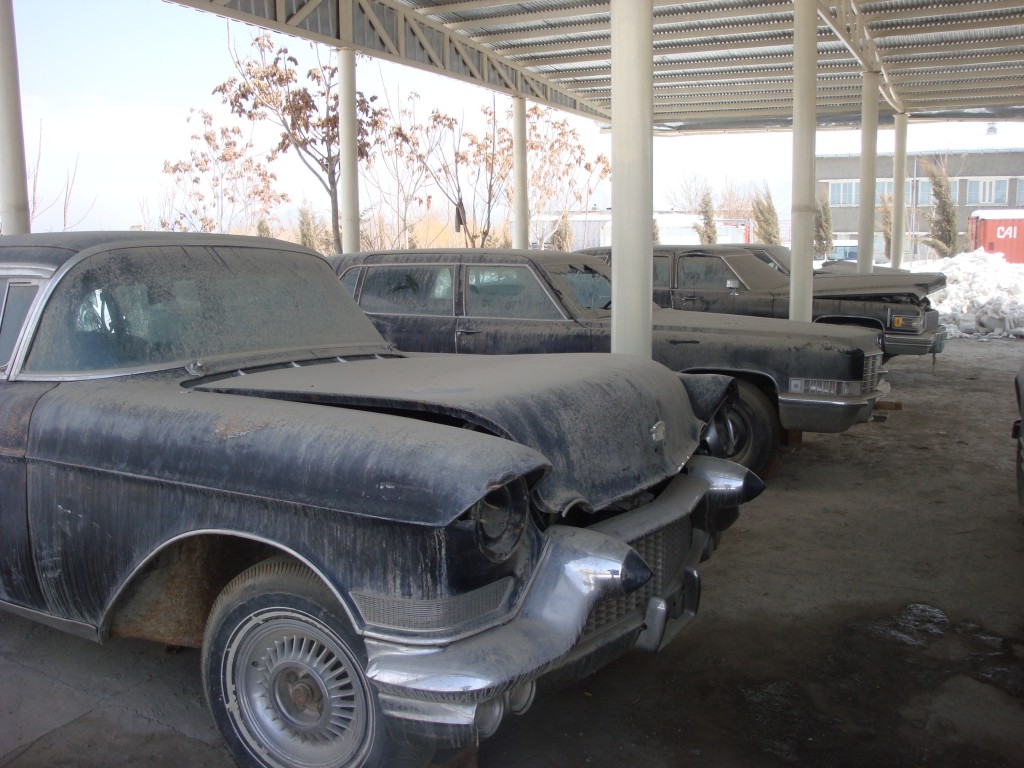
Next we went to visit the old palace, however, we weren’t able to get in because it had been mined.
From the palace grounds we could see this guest house, which they are in the process of retrofitting.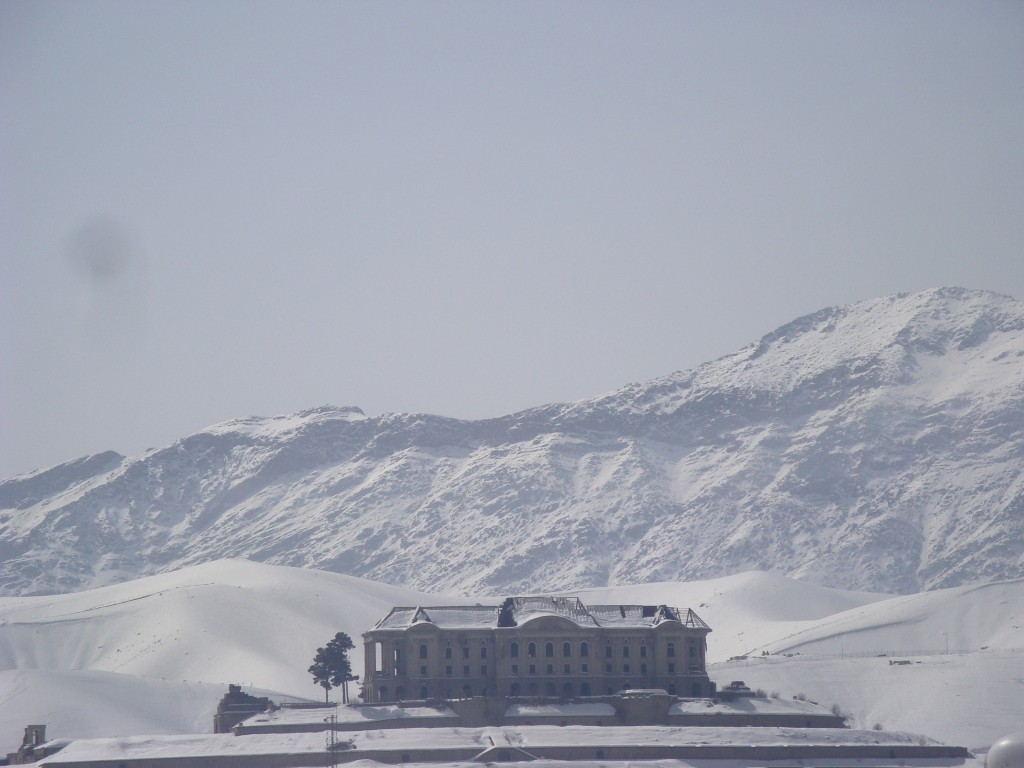
After that we went to visit Abdul Hakim Mujahid, who currently serves on Afghanistan’s High Peace Council. There was heavy security getting into his office, we had to sign in, they took pictures with our cameras to make sure they weren’t bombs, and we walked through a cavernous labyrinth before we reached our meeting room. Abdul Hakim Mujahid had been the UN representative for the Taliban for 4 years from 1997-2001. When we met him he was working on an address for the Taliban in Qatar. He stressed the importance of sharia to the Afghan people, saying they had always been the law, and that although the government has changed, the laws cannot. 
Lastly, we visited Nasima Paymar of Nasima Silks and Zarif Designs. Like Fatima, she is a widow who founded her own business with help from B-Peace. Everywhere we went they gave us tea, but Nasima also gave us delicious dried mulberries to get us through the end of the day. Below you can see her showing off some designs in the factory, the women working didn’t want their pictures taken.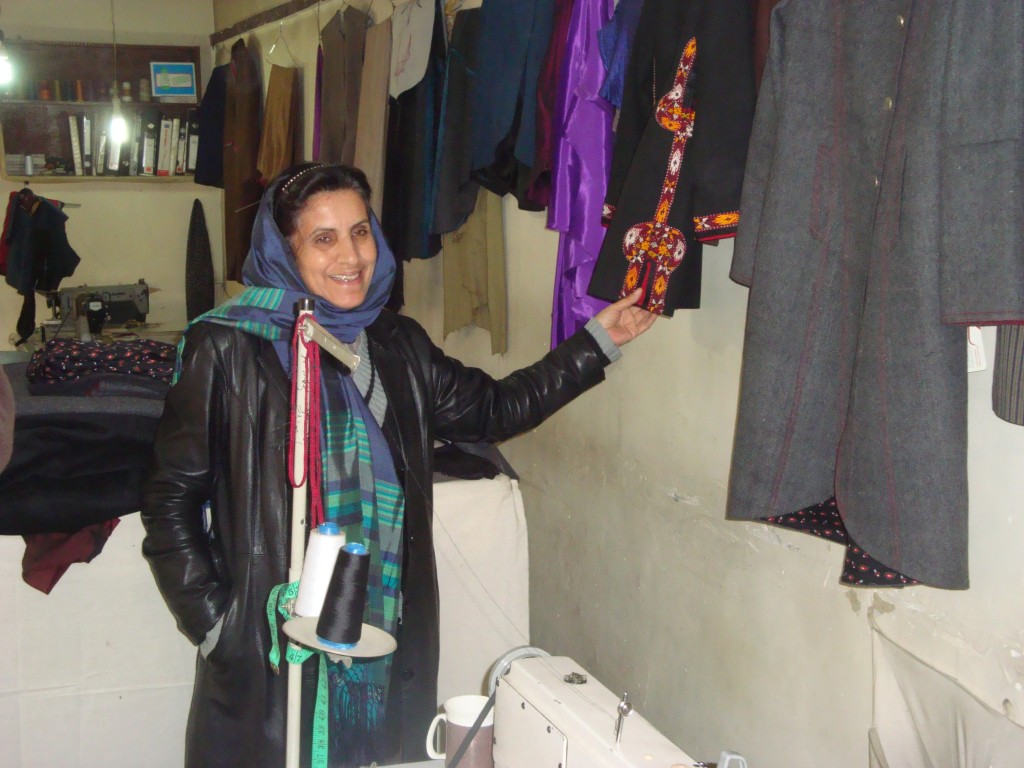
Thanks again to Tim for the sweet photos!
Day 4 was probably my favorite day of the trip. It may have a lot to do with the fact that I finally slept through the night after Day 3. The time difference from California to Kabul is 12.5 hours, so it took me a few days to adjust.
After my first good night’s sleep we went to visit Mahfuza Folad of the Justice for All Organization. I had done some volunteer work for her, online, from Chicago. They advocate for human rights including women, children and prisoners.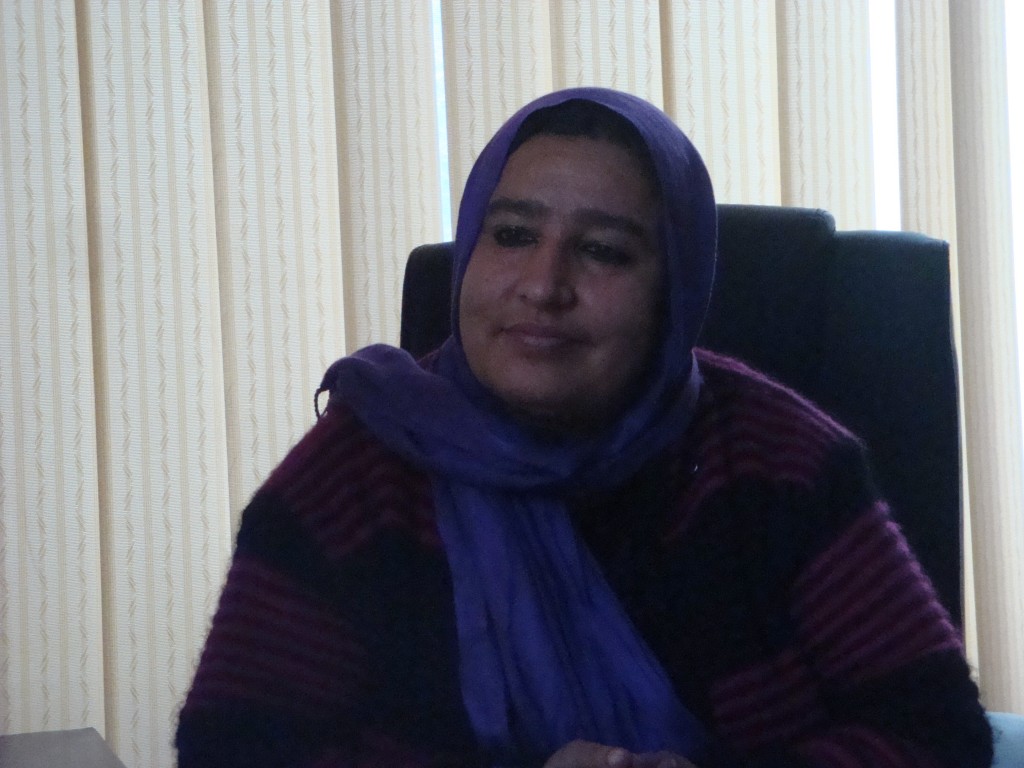
Next we went to visit the Peace Training and Research Organization, an Afghan NGO that does research and analysis in Afghanistan, focusing on hard-to reach provinces. These two were my favorite organizations and people we visited, I will talk more about them later.
Across the street we saw a girl’s class for Shin Gi Tai (New Full Contact) martial arts. The woman on the left, Monesa, was a 16 year old fighter who has already placed at international competitions. Kick Ass!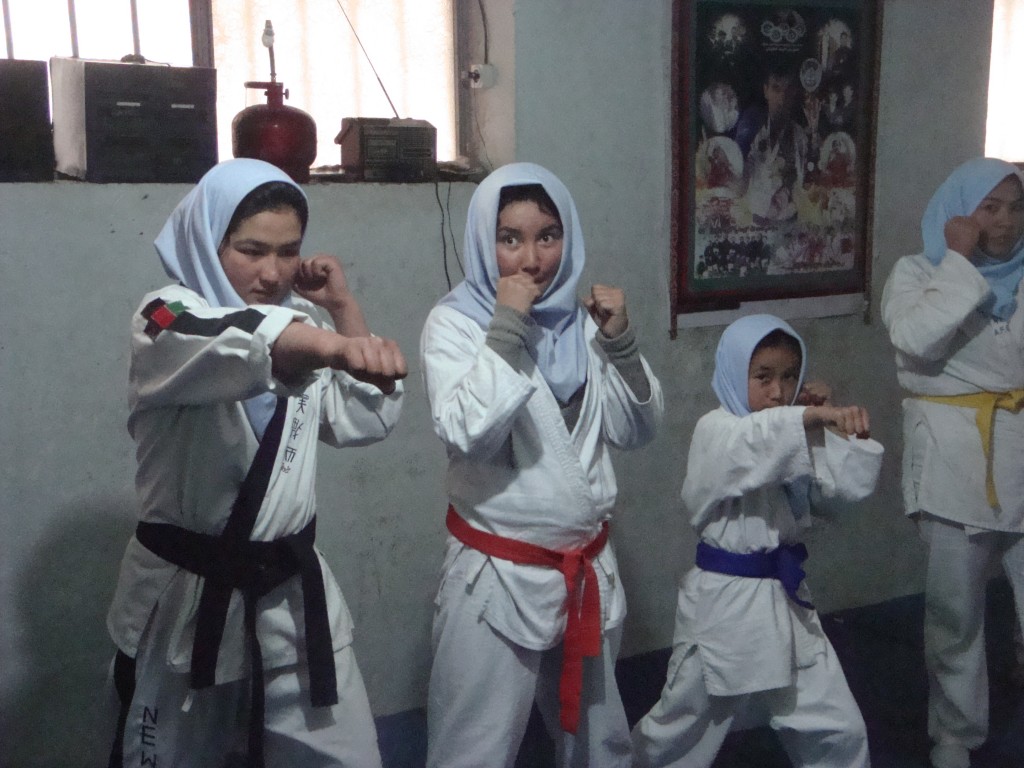
Downstairs was a bakery, where this man separated hundreds of eggs a day to make cakes and cookies. It was nice and warm down there.
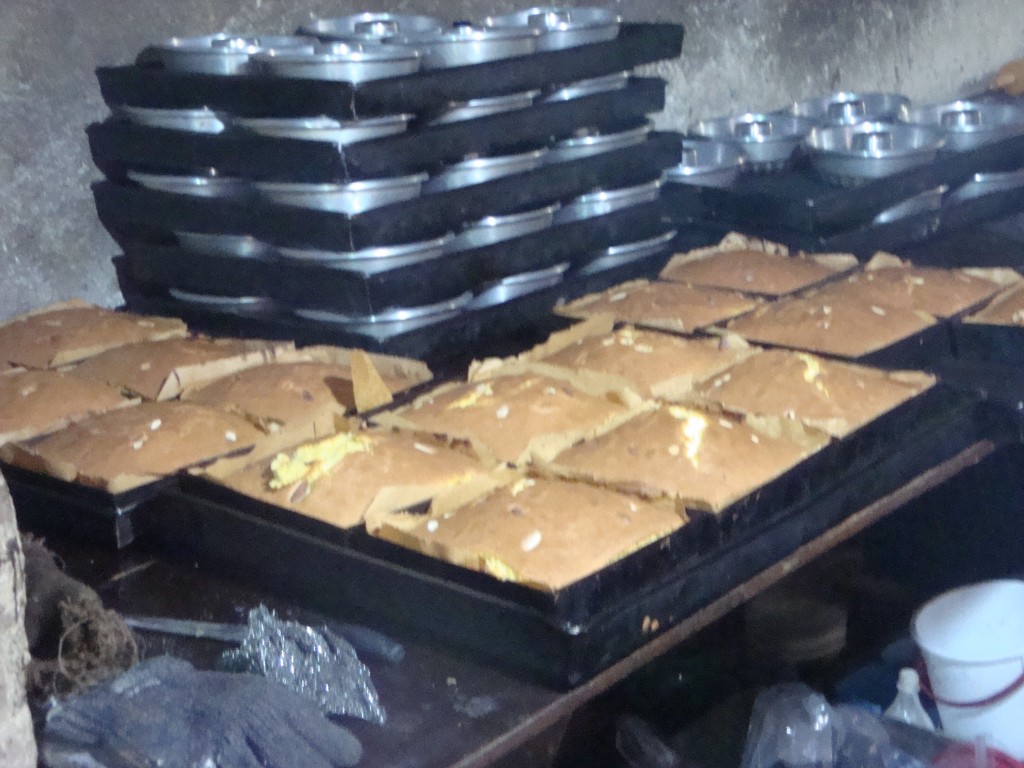
We started out by visiting the red cross orthopedic center in the morning. Our tour guide, Najib, had worked here during the war. 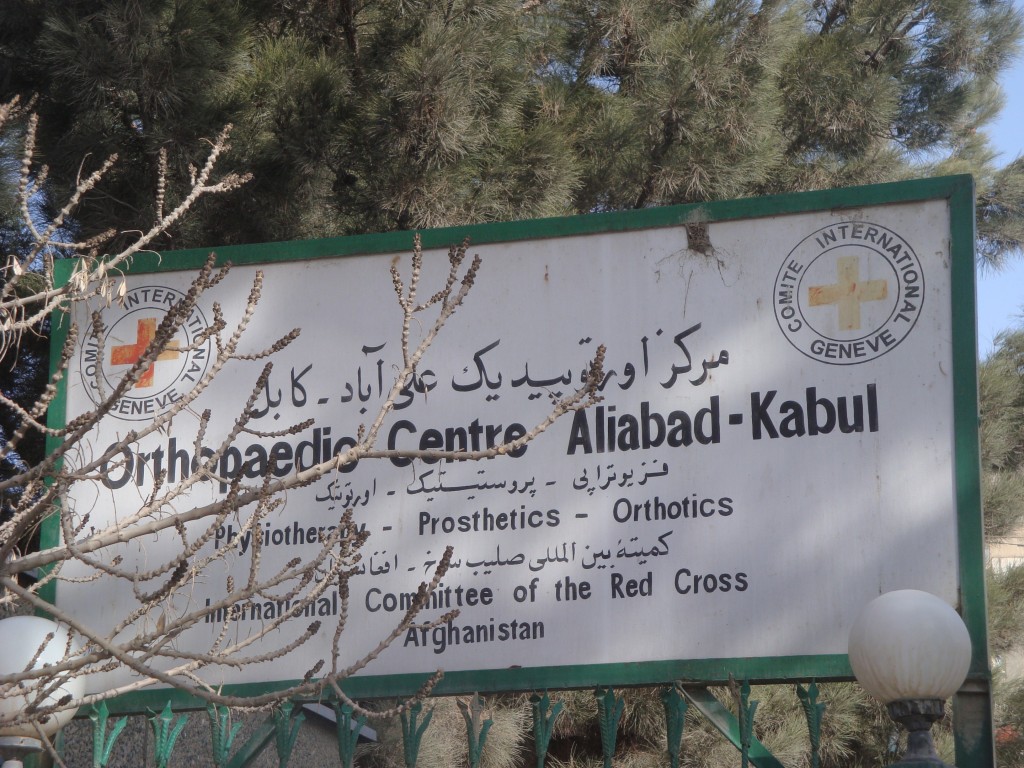 We met with the head of the orthopedic center, Najmuddin Helal. In addition to providing medical services for disabled people they also provide social programs, educational, vocational and employment. The factory to make the prosthetics was on the same site of the hospital and they only employed disabled people a type of affirmative action which he referred to as ‘positive discrimination.’
We met with the head of the orthopedic center, Najmuddin Helal. In addition to providing medical services for disabled people they also provide social programs, educational, vocational and employment. The factory to make the prosthetics was on the same site of the hospital and they only employed disabled people a type of affirmative action which he referred to as ‘positive discrimination.’ 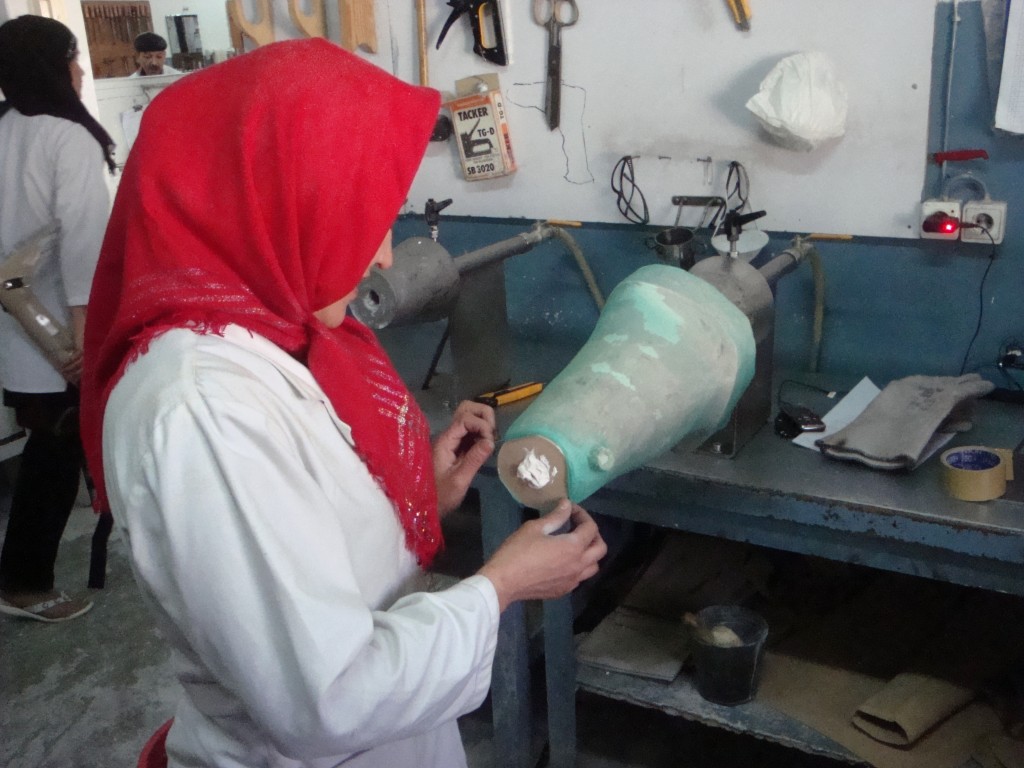 Najmuddin Helal himself had lost both legs to a mine in 1988. He told us that 80% of the amputees who come for treatment are victims of land mines.
Najmuddin Helal himself had lost both legs to a mine in 1988. He told us that 80% of the amputees who come for treatment are victims of land mines.
After meeting victims of mines it seemed fitting to visit the OMAR mining museum. In it they had examples of every different mine they had found in the countryside including the small butterfly mines that are particularly dangerous to children. They had educational materials, posters telling people not to step in unchecked areas as well as classrooms and even an internet cafe inside an old helicopter. OMAR is a de-mining organization and we saw their name on the side of the road elsewhere, indicating that this place was free of mines.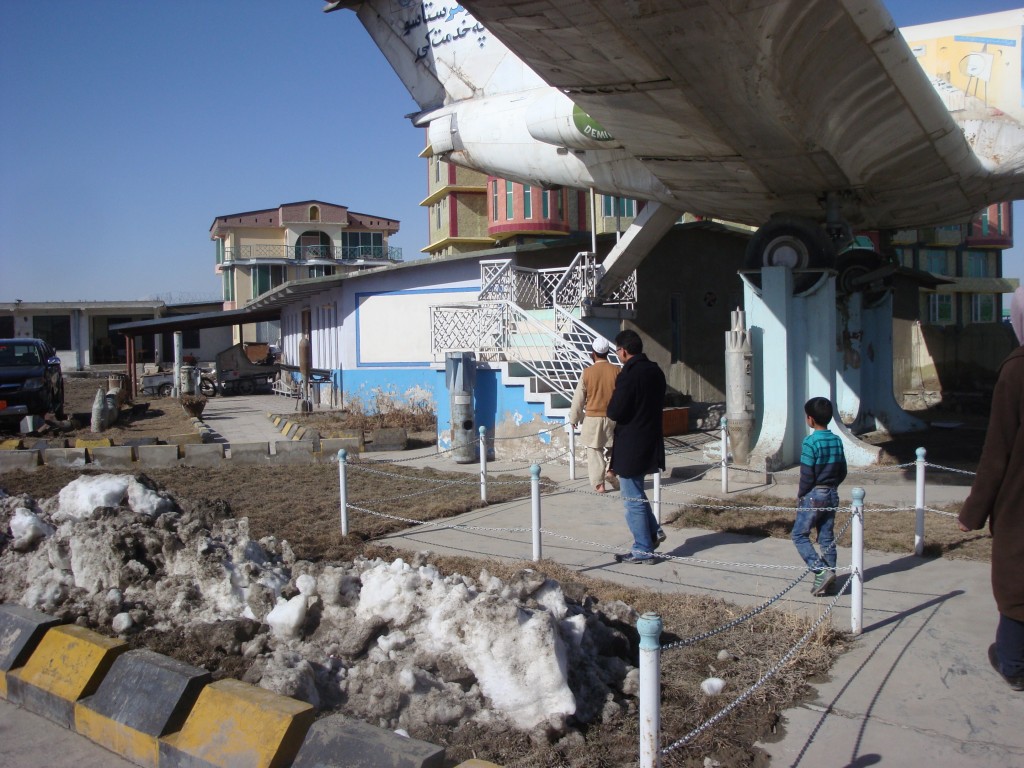
Also that day we met Fauzia Kufi the Parliamentary representative from Badakhshan and the chair of women’s rights committee. When asked how she came to power she explained that she comes from a political family; her father was elected four times and her older sister represents Tahar province. She expressed some uncertainty about Afghanistan’s future and the future of women. She said she hoped that the US would wait to pull out troops until after the elections in 2014.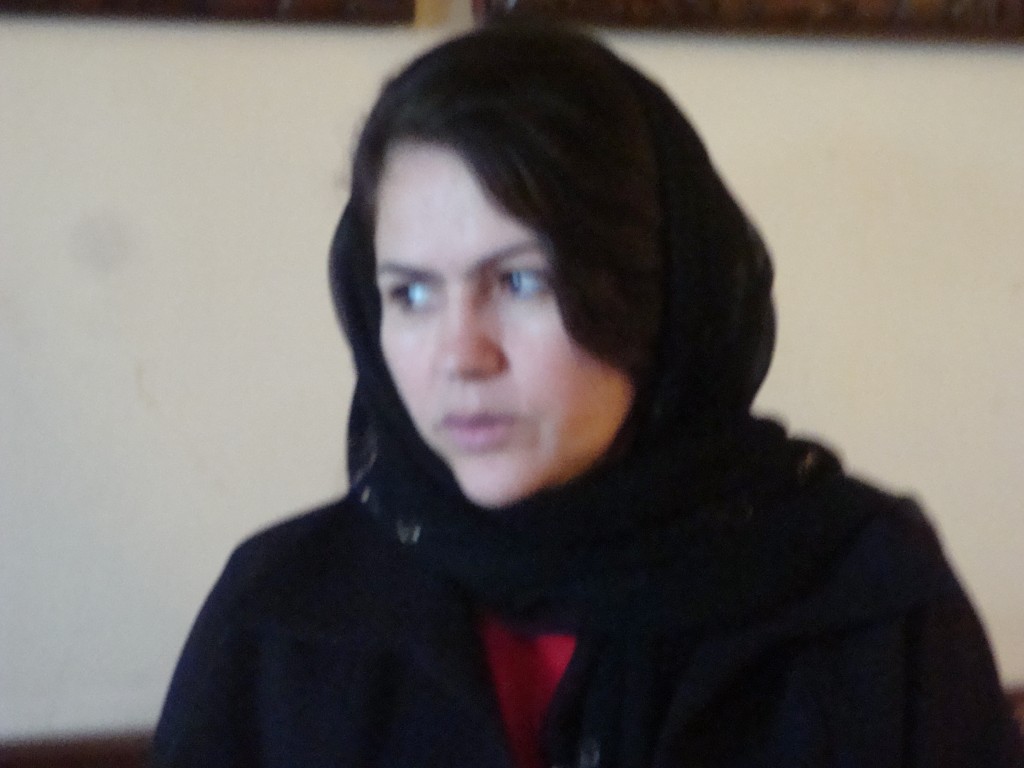
Later that day we went into Old Town to take some pictures. Everyone we met was excited to show us what they were selling.
On our way back to the car some kids across the street were throwing snowballs. As I was stepping into the car one of them hit me square in the face with a dirty snowball. It didn’t really hurt but I was pretty shaken up. Boys will be boys.
On Tuesday we went to Killid media group and met with Najiba Ayubi, the Media Director there. Radio Killid was the first free media after the Taliban, now they have 8 radio stations, 3 magazines (news, women’s, and culture), as well as a website and TV station. Her aim was to have the international news about Afghanistan come from the Afghan media.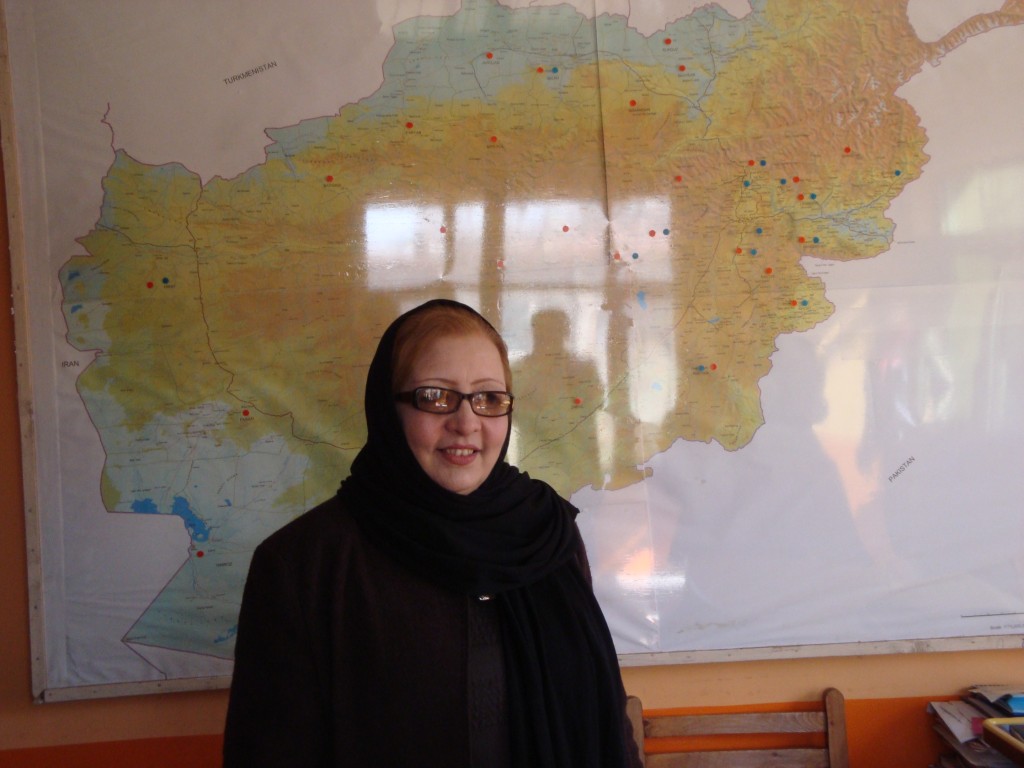
Later we went to the National Gallery to see more modern paintings including this famous painting depicting the last British survivor of the Anglo-Afghan War in 1842.
We visited this mosque
Took pictures of the Kabul Wall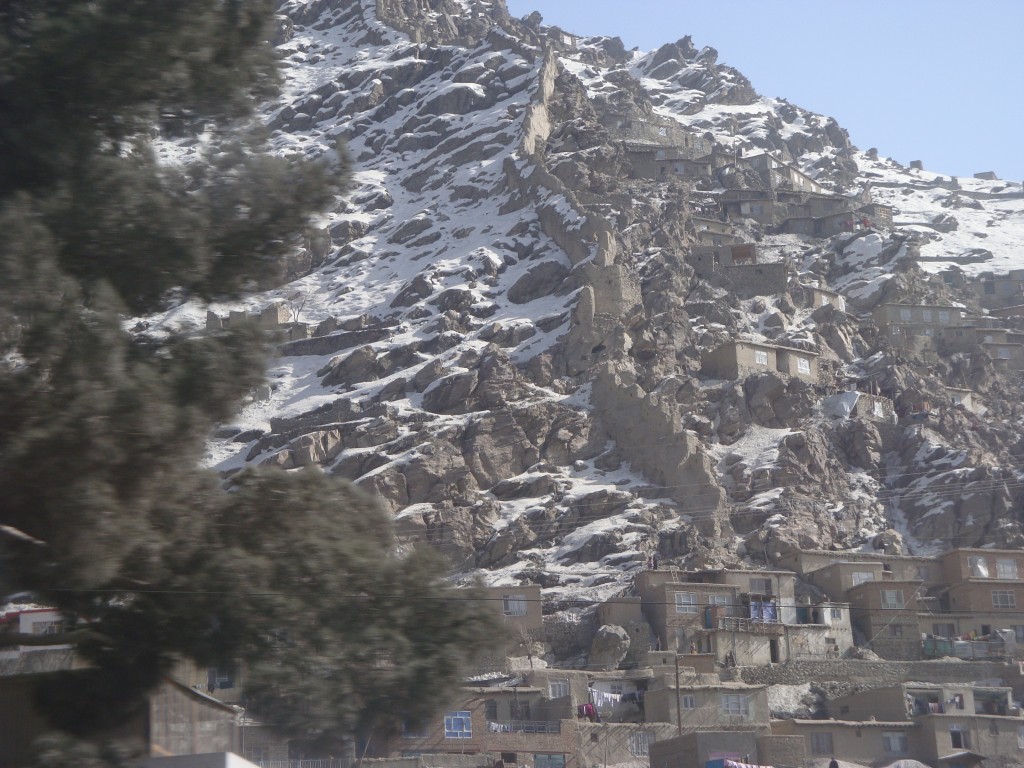
And thanks to our fearless driver, drove some treacherous streets up Guzarga mountain to take pictures from the the top where a cannon used to set off at noon every day.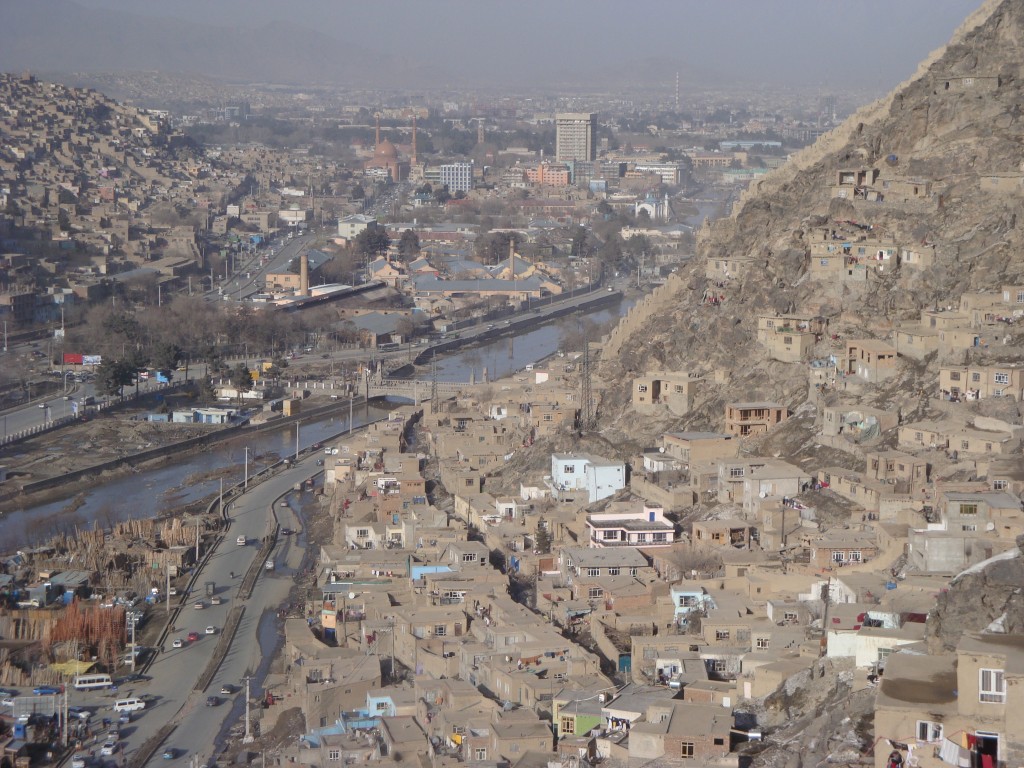
Day 7 was kind of a Great day. I think it was Day 4 that we visited all the places I wanted to go, which was fun, but Day 7 was inspiration day. In my brain I differentiate between good and Good, good is just an adjective eg, lunch was good; Good is a moral claim, it implies character, virtue; the Olympics are Good, Sylvia was Good. These were all Good organizations. On March 7 we had visits with 3 Good humanitarian agencies, in fact if I was going to chose 3 organizations to publicize it would be these three. They all do great work, have mass-appeal and really need our help. If you’ve got a couple extra bucks that you got back from your taxes you might want to send them this way.
The first was Aschiana, meaning bird’s nest. It is a school for street children.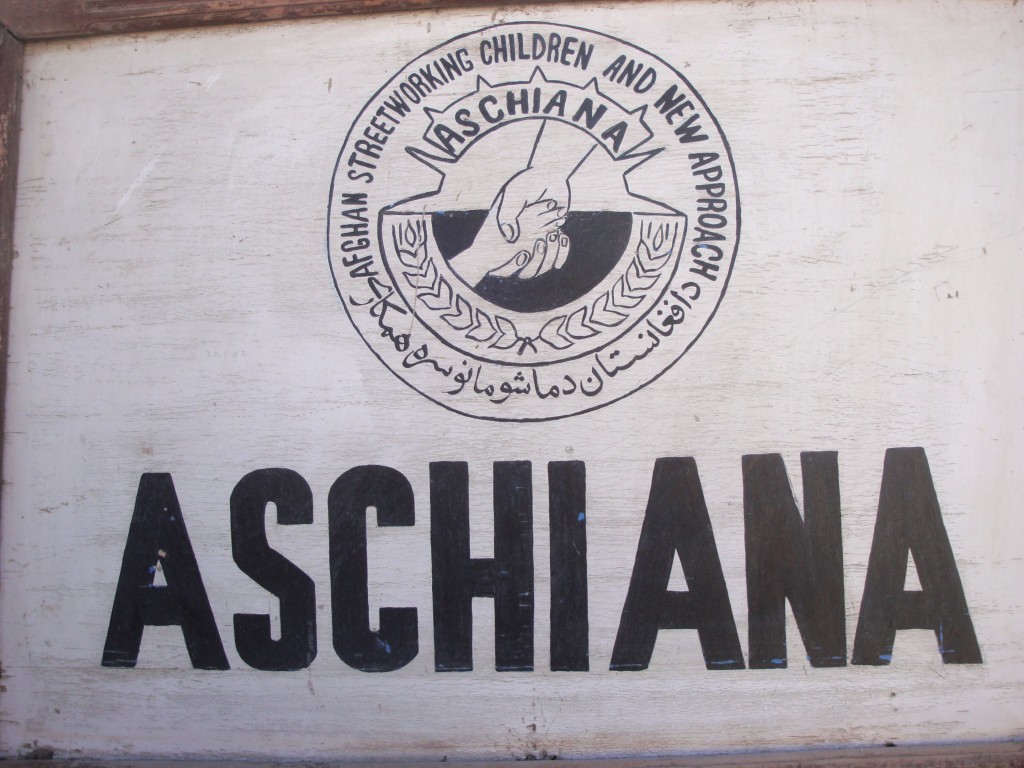
The organization recently published some statistics finding that Kabul has 60,000 street children and the number is increasing. Due to budget restrains Aschiana can only help the neediest, so in order to qualify you must either have a disability or a single parent. This is a picture of the founder, Mohammad Yousef, with a disabled child.
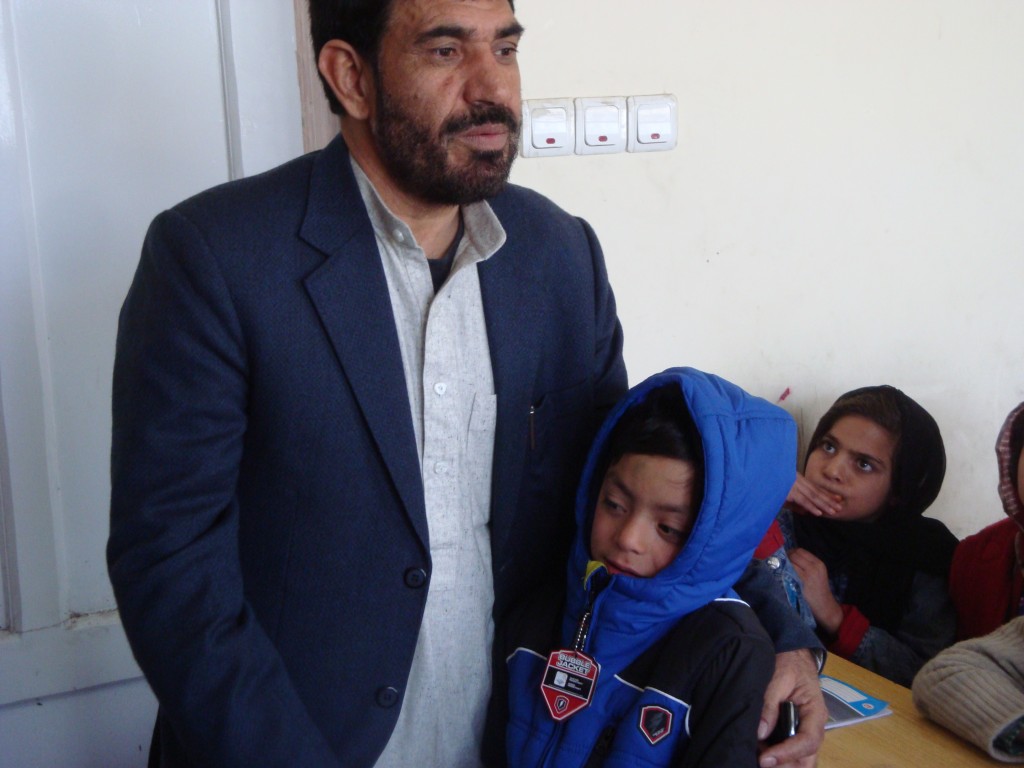
Below you can see some of the art that the children have done. I think their version of the famous ‘Remnants of an Army‘ painting is even better than the original.

The kids were taught in shifts; conventional subjects and also trades including woodworking and calligraphy. Until recently they were also taught theatre and music but these programs were cut because they couldn’t afford to pay the staff.

At lunch we met with Wahid Omar from Afghans for Tomorrow. Afghans for Tomorrow is a pretty great organization, organizing educational, agricultural and health programs across the country. What was most important to us though, is that they let us stay in their guest house and provided our wonderful tour guide. Without A4T I’d never have gone to Afghanistan, and you wouldn’t be reading this blog!
Finally, we went to see Jamila Afghani of Noor. All of us were so impressed by this lady; a handicapped Afghan woman from a conservative family with a Masters in International Relations and a PhD in Islamic Studies. She has been a women’s rights activist for many years. She recently started a program which trains imams in women’s rights from an Islamic perspective. Through their sermons she hopes to inspire and educate the public. 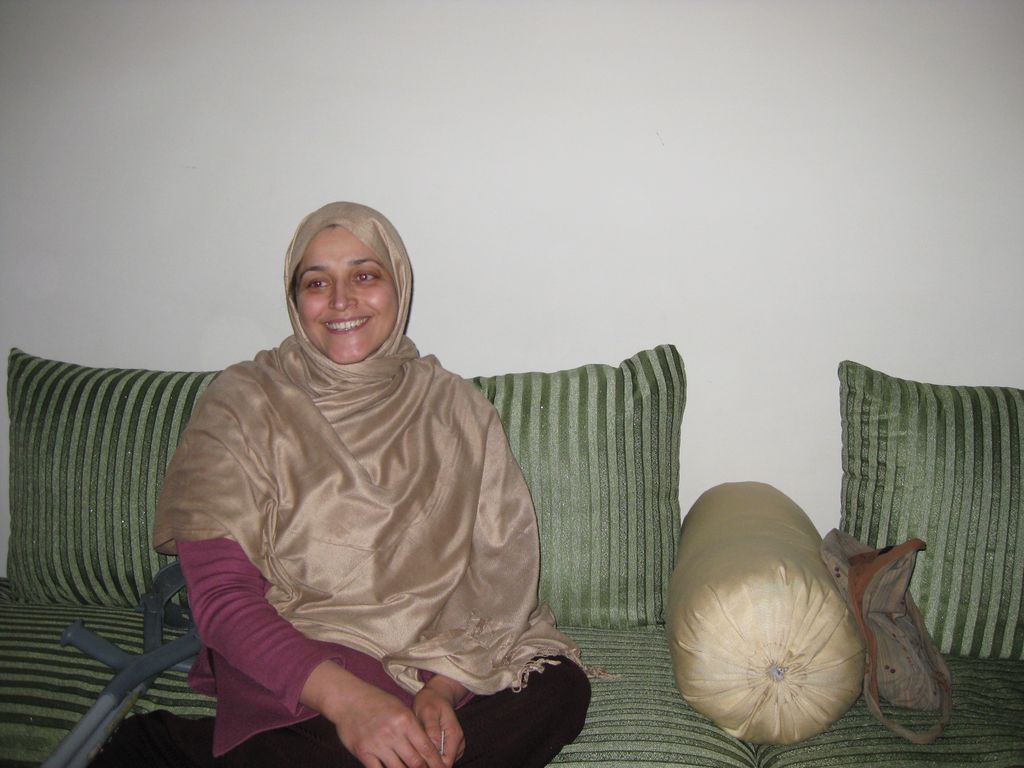
International Women’s Day – March 8, 2012
The theme of my trip to Afghanistan, 3 months ago now, was the celebration of International Women’s day but we almost didn’t get to go. For days we had been hearing about the fair-like atmosphere of the celebration, women selling goods, speeches (Karzai made a surprise visit the year before), and every day we went to the Ministry of Women’s Affairs for our official invitations. 2 days before the celebration we waited in the car while our tour guide went into the ministry, he came out saying ‘I have good news and bad news: the good news is I finally have your official invitations, the bad news is that the festivities have been postponed until the day after you leave because of the Kabul city-wide furlough days.’ I was speechless, I had spent so much time around men, in their space, I wanted to finally be in the women’s sphere. I had been so looking forward to this day, this was what the whole trip was about. I was beyond disappointed
We came up with an alternative plan. We had been discussing taking day trips to other provinces and cities and one of the ideas was to go to the Panjshir Valley to see Massoud’s tomb and the countryside. On the way we would go through Parwan province and see if they had an any Women’s Day celebrations since they weren’t subject to the Kabul city furlough. We found out that they had a celebration in a hotel in Charikar, the capital of Parwan province. After being thoroughly patted down we made our way upstairs and were seated in the front row of the celebration, next to the Governor and other dignitaries. We stood out, as always, this time because we had men with us in the womens’ section. The format was to be similar to Kabul’s celebration, speeches, skits and songs, formal gift-giving, followed by a women’s bazaar.
I took some terrible footage, here is a clip from the invocation:
After that we heard from the Governor, who told us many stories, including ones from the Qur’an about the role of women in society. Then a speech from the Minister of Women’s affairs, a children’s choir, a women judge spoke with passion, a skit about domestic abuse, and women of the police force were awarded plaques and gifts. They asked us to buy things at the women’s bazaar before we left, so we bought some cakes which we gave to a poor child on our way out That afternoon we went to the Panjshir Valley.
Panjshir Valley – March 8, 2012
If you read the FAQs post you know that my camera got stolen with most of my pictures on it. I did have some other pictures on a separate memory card though and my friend just lent me his cardreader so here they are.
These pictures are all from one of the last days of my trip when we drove outside of Kabul to the Panshir Valley.
This is the Panjshir River. The Panjshir valley translates to 5 Lions, and refers to a family from there than had 5 brothers.
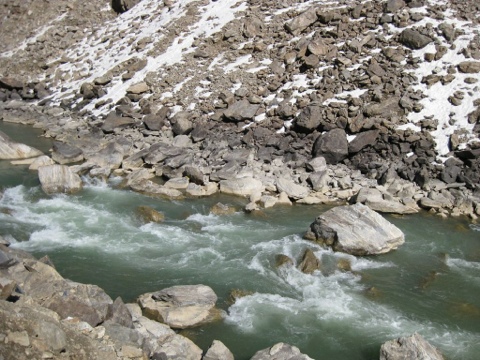
We stopped to eat kebabs at a restaurant by the river. I stuck my hand in the water, it was…not warm. In early March the snow was just starting to melt.

This valley is famous for being the birthplace of Ahmad Shah Massoud – an Afghan hero in these parts. This village had his picture on their bridge.
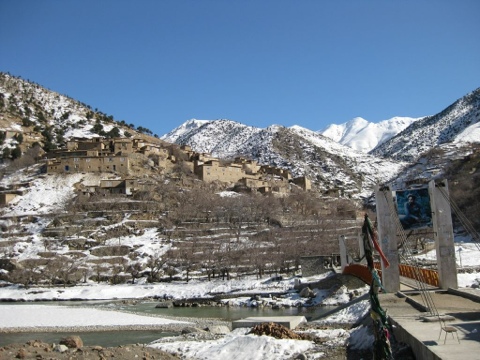
We were relieved when our tour guide told us that it was duck season and the men we kept seeing with rifles were just duckhunters.
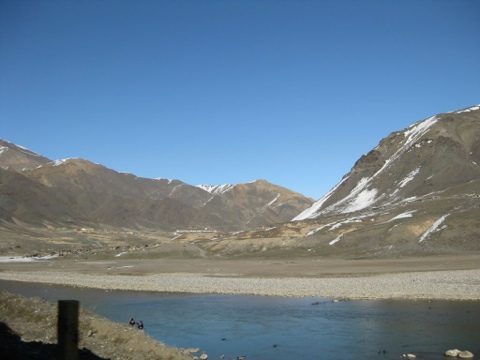
From Massoud’s tomb you can see the Panshir valley. The crops were just starting to come in, I’m sure now it’s very green.
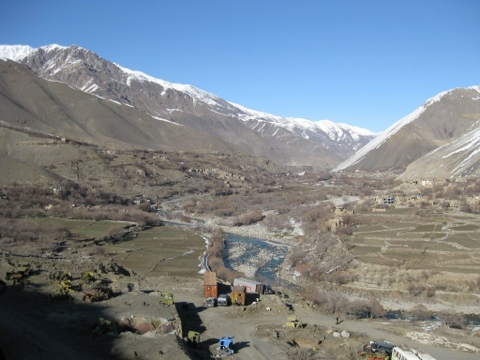
These are some pictures of the monument and the tomb where Massoud is buried.
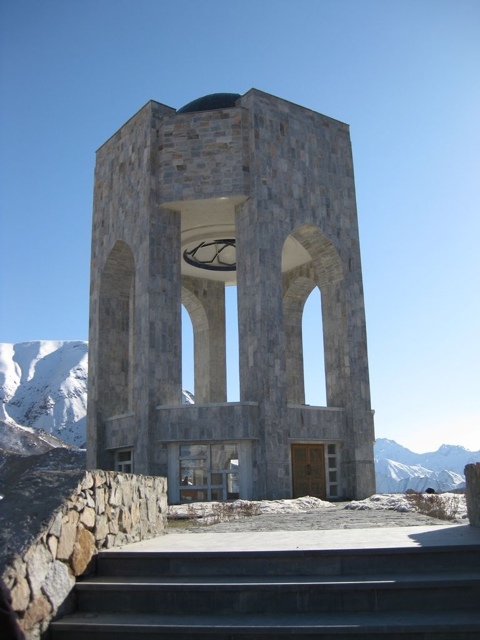
You can see they were doing some construction to build a museum and a new parking lot.
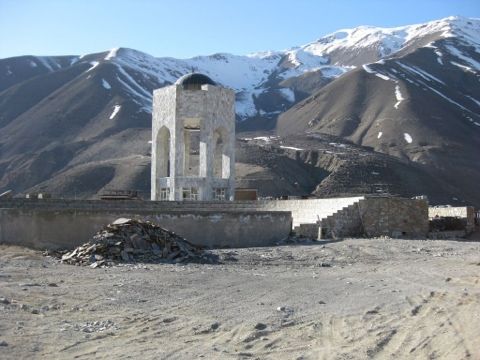
These are some views from the top of the hill.
Discomfort Zone – March 23, 2012
I’ve read 5 whole books in the past couple weeks. Okay, so each of these books should have taken me less than a day to read and they were mostly distractions from the more serious book that I am ostensibly reading, but they were all great. I read, the Hunger Games Trilogy, Brokeback Mountain (I know it’s a short story, and I actually read most of the stories in Close Range but this one was on its own, so it counts), and Is Everyone Hanging Out Without Me (and other concerns). Instead of giving a book report about how great the books were (and all these books were great, except Mockingjay was just okay), I’m gonna talk about my experience reading these books (because a blog is like a therapy session, narcissism is allowed), if you want to know the plots, read them yourself, or watch the movies. I won’t give anything away.
I started the Hunger Games when I left for Afghanistan. When I was working in New York publishing I heard about and saw so many good books that I realized I couldn’t read everything and I was going to need a some ground rules. I settled on this, if I get 3 independent recommendations for the same book it is worth sinking my teeth into (now my definition of the word ‘recommendation’ is extremely broad and in the past I have included the fact that a book is on sale as a recommendation). I had heard good buzz about the Hunger Games so when David Plotz recommended it on the Double X Gabfest, I was waiting outside a local bookstore before I left for New York and I had a new (miles-earning!) credit card burning a hole in my pocket it was the American Express sticker on the door that served as my final recommendation.
I slept on the plane to New York, and while there I was amused enough that I didn’t start reading the book until my flight from Frankfurt to Dubai. By the time I got on the flight from Dubai to Kabul, Katniss was leaving the Capitol for the Hunger Games arena. The irony was not lost on me.
Katniss was prepared, she had her knowledge of hunting, her experience with hunger and her determination to avenge her sister. I had a couple years of Persian and Pashto, experience traveling abroad from an early age, and the determination to stick it to all the haterz who thought I shouldn’t go to Afghanistan. Katniss had her Mockingjay pin, I had postcards from my hometown. Katniss was leaving a land of excess to a go to an impoverished war zone; I was leaving Dubai to go to Kabul.
America is fighting a war in Afghanistan. Apparently Suzanne Collins got the idea for the Hunger Games while watching TV; she was flipping between a reality show and footage of the Iraq war and they started to blend together. The hunger games is, in a way, an extreme reality show, like Survivor except you dont get voted off, you get killed. The destruction is highly televised, the humanity isn’t. In the states, the footage we get of Afghanistan is all of war and destruction. I got to Afghanstan days after the Qur’an burning and the streets were calm, not burning with American effigies. Our tour guide told us that there had been some peaceful protests where the police took care of security, but that these were over. The people we talked to were very upset about what happened, but they had heard Obama’s apology and they understood that it was an accident, they also said their mullas had told them to be patient and calm. These sorts of discrepancies made me wonder whether Kabul was like district 13; had the American media been showing the same loop of angry protestors burning the American flag over the sound of the muezzin? I had all but stopped reading the news coverage of Afghanistan by the time I went to college, I knew people in Kabul who went to work every day, it couldn’t be the burning war zone I saw on TV. What was really going on?*
I wanted to see for myself, and talk to some people, but in a city like Kabul, where billions of dollars come in from foreigners every year, who can you trust? Everyone has an agenda. Even our tour guide wants to show the best face of the country, and his livelihood depends on keeping us happy. We took a lot of pictures, but like the tributes in the arena, everyone knew we were watching from home. How do you smile when you know someone is watching, when they have the ability to drop help from the sky? We interviewed, and filmed, and tried to get to know people and tell their stories, but our time was short and I’m sure some of their messages were lost in translation.
The Hunger Games had a focus on appearances, style, costumes and camouflage. Having never worn a headscarf before, the hijab felt like a costume to me, and I tried my hardest to fit into it. I didn’t have Cinna (or Lenny Kravitz) to help me prepare for the my arena so I just had to wing it. In a way, there is no camouflage more perfect than the burka, hiding in plain sight. I didn’t wear the burka, but with the hijab I could be similarly incognito. At the end of the day instead of looking up to the sky to see the score and hear the anthem, I lay in my bed and listened to the muezzin and wrote about my day.
I tried many things to distract myself so I wouldn’t finish the Hunger Games and I could save it for the trip home. I read a copy of Brokeback Mountain that I found in the guest house, I blogged about my experience, I went to bed early, but in the end, I finished the book, counting on the fact that I would soon be able to buy the sequel in the Dubai airport.
One of the themes in the Hunger Games was fire; the coal in district 12, the way Gale smells like smoke, Katniss’s costume, the fires in the arena. As it was late winter in Afghanistan, fire became a theme of the trip too, children sold smoke for good luck, men warmed their hands in small fires, we visited bakeries where people were crowded around ovens and by the end of the trip each of us smelled like smoke too because each of our rooms in the guest house was heated by a wood chimney. The only time I think I was ever in danger on my trip to Afghanistan was actually in my own room. I was trying to read and was starting to nod off when my room started to fill with smoke. I thought it would go away, and tried to sleep, but I started coughing and noticed by flashlight that the room was hazy, I couldn’t see very well. I was so tired I couldn’t be bothered to get up. When my eyes started to water I tried to open the window by my bed, but the window was covered in plastic to keep the heat in so it wasn’t doing any good. After a few more minutes of coughing I put on my headscarf and went to get the guard. When I opened the door, I saw his look of surprise as smoke billowed out of my room. For a second I felt like Katniss, escaping from the fire that woke her up in the night. But mostly I felt like an idiot when Naqib told me his solution was just to open another window and leave the door open for a few minutes.
On the way home I prepared for my presentation in my hometown. The trip had changed me, and I needed to show that, but I also wanted people to recognize that I was the same person, and that I hadn’t been corrupted by the Middle East. Mostly what I felt though, was dirty. When I got to Dubai my first reaction was that the people looked so white and the airport seemed so clean. Arriving in New York, I felt even grimier after 15 hours on a plane, like Katniss after the games, I needed a skin polish before I got home. I settled for an overpriced mani pedi at JFK.
*I really do not mean to denigrate the journalists who risk life and limb to report the ongoing war. I have the utmost respect for them and the work that they do.
I’ve been postponing writing about my experience at the refugee camp because it was really difficult and scary for me, but I think it’s important to write about my experience and share it with others. When we checked in with Global Exchange a couple months before the trip we talked about our itinerary and I was a little worried that our itinerary wasn’t more firm. I’m a planner, and I like to learn about the organizations we are going to visit beforehand. The people at GX said that the reason why our itinerary was not more firm is because of security, that we may be visiting places like an underground school and a refugee camp and that for security reasons they had to keep our plans flexible. After our first day in Kabul I realized just how flexible our itinerary was, after getting of the plane, we visited 3 places that were slated for different days. Our tour guide asked if we wanted to go see a refugee camp; I had no interest in doing so, however my fellow travelers convinced me that this would be a singular experience and I had vowed to be more adventuresome on this trip. Our tour guide said if we go to the refugee camp that we should go on a Friday, the weekend, because on this day there would be more people to interview; the men work during the week. So we decided to go to the refugee camp that day.
In the morning we went to see Kargha Lake nearby, in the car, our tour guide Najib talked to us about his country. He explained that most Afghans don’t hate Americans they hate the Pakistani Military and the American policy. Although they felt there were improvements under Obama, they felt that there could only be progress in Afghanistan when American stops giving money to the Pakistani government which is funding the Talilban. Although he said there was not very much anti-American sentiment in Kabul, he said that we might find some in this refugee camp. He told us that the people in this camp were from Helmand province where they had been displaced due to US and Taliban bombing. Najib explained that the reason why we were able to get into this camp is because he knew one of the camp leaders whose name was Ismail. Najib had been a surgeon during the war had taken Ismail’s son to the hospital, this is how they knew each other. Najib also explained that we may have heard about this camp because the New York Times had recently written a story about it because they had a particularly difficult winter and some children had died of exposure.
This was our second day in Afghanistan. I didn’t know the tour guide well, I didn’t know my compatriots well and, although I had read about it for years, I hadn’t really experienced Afghan culture. I would later come to understand that all these people had my best interests at heart, but walking into the refugee camp was shocking and terrifying to me. It was early spring and everywhere we went the ground was partially frozen. The sidewalk in Kabul isn’t always paved and in this part of town it was not only muddy but smelled of raw sewage. When we walked into the tent city we were greeted by Ismail (Najib had called him on his cell phone), and other elders, as well as children who were curious about these strangers in their midst. As we walked in, sat down and waited for the journalist to set up her equipment, I decided to do what I normally do in situations that confuse and intimidate me, I observed carefully, took copious notes and sought to understand what was going on around me.
As we walked to the tent we all took off our shoes, as is the custom in Afghanistan, but our hosts insisted that we keep our shoes on. The hospitality and generosity of the Afghan people was a recurring theme on the trip. I think there was a thin rug covering much of the ground, but I sat in the corner and the ground was completely frozen. Aware that showing the bottom of one’s feet is considered rude, I chose to sit on my heels, either because of the cold or because of my seated position, my feet were quickly numb. As Salena began to set up her video equipment we were served tea and men began to file in.
There was Ismail, Najib’s friend, who was one of 6 elected elders of the camp. There were two other men we spoke to (Ruzi Khan and Khoja Mohammed), and then there were maybe 10 other people in the tent. All men, all staring at us. I felt scared and out of place, I did not know the customs of this tribe. In college I studied Persian (Farsi, as spoken in Iran), I did manage to take a summer of Pashto language, but I am really unfamiliar with their tribe and customs and even less familiar with the language and culture of men. Culturally speaking, I didn’t belong there, I belonged with women, somewhere else. I didn’t see any women at this camp, they were in different tents. Just men, and their sons, staring at myself and my colleagues.
Ismail began by introducing himself and explaining where he was from in Helman province, a village called Minrodai. There were 850 families in the camp, which had existed for about 5 years and the majority of families there had lost a family member. Most of the people in his town were farmers, wheat and vegetables mostly, but their land had been destroyed, their homes, everything had been lost. They said that the majority of the destruction in their area must have come from Americans since the Taliban doesn’t have aircrafts; he told a story of 2 jets that had come and dropped bombs on their village. As he spoke men kept coming in and out. There was only one door in the mud tent so when someone came in the room would go pitch dark. We couldn’t really see their faces until they were in front of us and they would whisper something to Ismail and then stare at us. Salena was a journalist, doing her job, Tim, a middle-aged minister, having a conversation about cultural and religious understanding, and Najib was our translator, this all made a certain amount of sense, but who was this black girl with big white glasses and what was she doing there? I tried to blend into the wall.
Salena continued to interview Ismail, who emphasized a need for permanent housing. There is an expression in Pashto about the need for your own graveyard. Recently, NYTimes journalists had come to the camp, over the cold winter some children and an older woman had died because of the cold, and the elders took the journalists to their temporary graveyard. The ministry in charge of refugee affairs had given them wood, coal, blankets and tents but what they wanted was permanent housing, and daily work. The men had been going into town to work as laborers, but there wasn’t enough work. Ismail stressed that what he wanted was a small permanent house, his own graveyard and enough work. At this point Ismail became very busy with the visitors who kept coming in. He explained that his father had just returned from a pilgrimage to Mazar-e-Sharif, a holy place for healing, the visitors were coming to ask him about his father’s health and give him their best wishes. While I was relieved that the people weren’t just coming to ogle us, I was distraught as Ismail left to talk to these visitors and another man began to talk.
Khoja Mohammad took over and explained to us how upset he was about the Qur’an burning at Bagram airbase. When talking about the incident after the fact, a colleague who hadn’t taken down his name, said he had referred to this man simply as ‘Angry Man’. Khoja Mohammad never screamed, but he spoke loudly, pointedly and aggressively, he was very angry that Americans had burned their Holy Book. Although we had explained to him what little influence we had, he told us to tell our people not to do this again. He explained that they were ready to sacrifice if someone did this again. They had planned to protest with the others but their leaders advised them to be patient, and explained that the burning had been a mistake. President Karzai and his ministers advised them to be patient, and Obama had apologized. But he said that the next time they would surely have a jihad.
Khoja Mohammad was also very upset at America for our treatment of Afghan civilians; he told us of wedding parties, town meetings, women and children being bombed. He knew that Americans had satellite vision so he knew that these civilians were being targeted intentionally. We were supposed to be helping Afghanistan to stand on its own feet, not killing their children. He said we should not capture innocent people and say they are Taliban. Khoja Mohammad talked about a friend at Bagram prison who should have been released, he had done nothing wrong, he is innocent. They had written letters and talked to guards and people in charge but to no avail. Khoja Mohammad said that not all men with turbans and beards are Taliban, that these things mean at you are a good Muslim. People with beards and turbans are not enemies, and we should not kill these men. We tried to explain that we didn’t know how we could help, but it didn’t seem to matter, he continued.
Khoja Muhammad said that they elected the president, and they respect him. The Qur’an said that God likes patient people, and so they were being patient. But the Qur’an burning was a terrible thing. They had lost children and an old woman over the winter, but this man said it was not as bad as the Qur’an burning. This holy book that teaches them right from wrong (halal from haram) and was written by God. He told a story about a tent, how without tent poles there can be no ceiling, but God is so Great that he can hold up the entire sky. And here we are burning His words, burning the words of Allah.
Salena asked what he wanted, what his wish was, and he echoed what Ismail had said about a permanent home and some permanent land. Then he continued about the Qur’an burning. He said that Afghans have respected our religion, and we should respect theirs. We explained that there were Muslims in America too, and he said that he knew this. The people who burned the Qur’an should be punished, he said, the US military is a guest in Afghanistan to bring peace. The man finished with the sentiment that they knew how to separate one bad person from many good people and that we should do the same.
Our guide and translator had explained beforehand that when visiting the refugee camp we would need to bring some money with us, the camp was very poor and it was customary to bring an envelope with money. After packing up we gave them some money we had collected for them and explained that it was a small gesture and that we would go home to our constituents and tell them their story, perhaps they would be able to send more money. They counted it and distributed it among the elders to show their transparency. Although it seemed like they had just spent an hour berating us, they didn’t seem to want to let us leave. They offered us lunch and more tea and seemed sad to see us go.
There were many children by the entrance to the camp, some asked us for pens on our way out, Salena and Tim took pictures of some of the children, they seemed very eager to have their pictures taken. I chose not to, partly because I was still in shock from the experience. I spent the rest of the day processing the experience. We talked about it as a group in the evening, for me, I was terrified to be in a room full of angry men staring and screaming at me for an incident I barely even knew about when we left. I felt very out of place. Others said they were surprised by Khoja Mohammad, how he kept returning to the subject of the Qur’an burning as we tried to ask him different questions. Although he seemed to know that we couldn’t do anything about it, he seemed intent on telling us, and repeating to us, that this was a very bad thing that happened and that it must never happen again. As a group, I felt like we were some of the Americans who were most sympathetic to Islam as a religion and to his story, but the fact that he kept repeating himself made me feel victimized and attacked. Like he was yelling and me, and angry at me personally for burning a Qur’an, when I had spent years studying his culture and religion in an effort to better understand.
As we were walking to the car, Najib asked me how I was doing (I think at one point I may have actually had tears in my eyes), and I answered that I was scared, that all these men were angry and screaming at me in a room that I couldn’t get out of. Najib explained that he would never have put me in a dangerous situation, that it was completely safe. Though I was still scared, and in shock, I believed him. The trip was not about danger or recklessness, it was about cultural understanding and human exchange. As the trip continued, I became more comfortable and trusting, but this experience was the most intense, and ultimately the most memorable.
Afghanistan War
When people ask me why I’m interested in going to Afghanistan, I always have a hard time answering because my gut response is ‘Why aren’t YOU?’ On September 11th I was at boarding school in Putney, Vermont and I remember reading this Boondocks comic that seemed to express what I was thinking.
My reaction to September 11th was an introspective one, I asked myself ‘Why do people hate us so much?’ and ‘Why didn’t we know before?’, ‘What have we done?’ and ‘What can we do to make sure these people don’t attack us anymore?’
A few years after the attacks I was a Junior in high school and I had the opportunity to meet a group of women judges from Kabul. Just learning that there were women who had been judges in Afghanistan complicated my view of Afghanistan. Actually meeting and spending time with them made me more and more curious about the people there and what they were doing. If there were women there going to work every day there must have been at least two buildings standing, their homes, and their workplaces; all I saw on TV was burning rubble. I became really interested in the people and the culture, what was sharia law? What was really the situation there? (Here’s a great video/interview I just found about everyday life in Afghanistan if you’re as curious as I was.)
I studied Afghanistan in college as a Near Eastern Studies major at the University of Chicago. I learned Persian and Pashto. I decided to double major in Geography because I kept finding that the problems in Afghanistan had to do with ethnicities isolated by geography. The colonialist boundaries had put two very different ethnic tribes together in one country (along with many other tribes and ethnicities, Afghanistan is extremely diverse, many people thought I was an Iranian-African from the Bandar-Abbas region). I wrote my thesis on how the legal systems in Afghanistan were distributed geographically.
As you know, a few months ago I went to Kabul. In Kabul I heard 3 things with surprising consistency, the biggest problem or challenge in the country was lack of security, everyone thought the Pakistani government was to blame for many of the country’s problems (that the US should stop funding Pakistan) and everyone we asked wanted to keep US or international involvement in some respect. We talked mostly to middle-class urbanites in Kabul, but this was the anecdotal evidence we were able to gather. You can see the evidence of 30 years of war in and around Kabul, in every neighborhood our tour guide pointed out a building that had a suicide bomb attack, the palace and museum were destroyed, we went through check-points almost every day. But I can’t imagine what it’s like in the countryside.
We did have a couple different points of view to complicate this. One was on the second day at a refugee camp, which I talked about in an earlier post. The other was in the village of Istalif at a small traditional restaurant. We were served a dish called chainaki (lamb stew served in ‘china’ – tea kettles) as we sat on the rugs. A few different men came in and out of the restaurant and we were able to chat with them informally, one of the few times we weren’t on a scheduled meeting.
First we talked to the older man who we called Kaka meaning uncle, a term of respect and endearment. He talked about life in his village over the years. He and his family did pottery and leatherwork before the revolution, and the bazaars were much bigger. He lost his business after the revolution and the village of Istalif lost 75% of their population. Most of the money from Istalif went to Kabul, but there were a few families who came back and are doing agriculture again (wheat, fruit, figs, apricots, apples and cherries).
There was also a young man who was up for the weekend, he runs a camera shop in Kabul. We talked to him and his friend for a bit. He said some Afghans thought the Qur’an burning was done by Brits and not the US. He talked to us a little about what Islam meant to him, and how if everyone followed the Good Book we would have no problems. They brought up some issues about Afghans who can’t get Visas to the US. They said if the US is really an ally they should let Afghans travel to the US on business. If we stay in the country, we stay as an ally, but he warned, if we stay and try to start a war that history will teach us what happens to people who try to take over Afghanistan. Persians, Indians, British, Russians, no one has ever held Afghanistan.
The more research I did about Afghanistan the more confused I was about US involvement. I wrote a thesis, studied the geography, learned the culture and even went to Afghanistan. If I had to characterize the Afghan people, based on my experience, I would say they are generous, resilient and hugely diverse. I essentially came to the conclusion that I can’t figure out why Afghans bombed us because Afghans didn’t bomb us, some crazy terrorists did, they happened to live in Afghanistan (well, Pakistan). I recently heard this statistic about how Islamic people are more likely to be the victims of terrorist attacks than the perpetrators. Fear cannot be the driving force in this debate, we must come from a place of diplomacy and compassion, not imperialistic hubris. But I still can’t tell whether it’s right to stay in the country, helping people as well as killing people, or to leave, abandoning them altogether.
